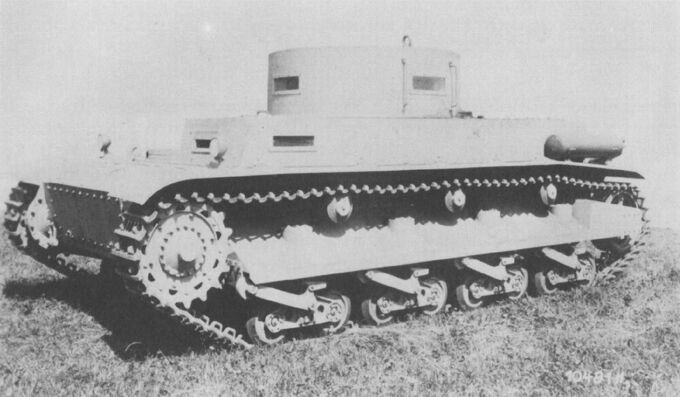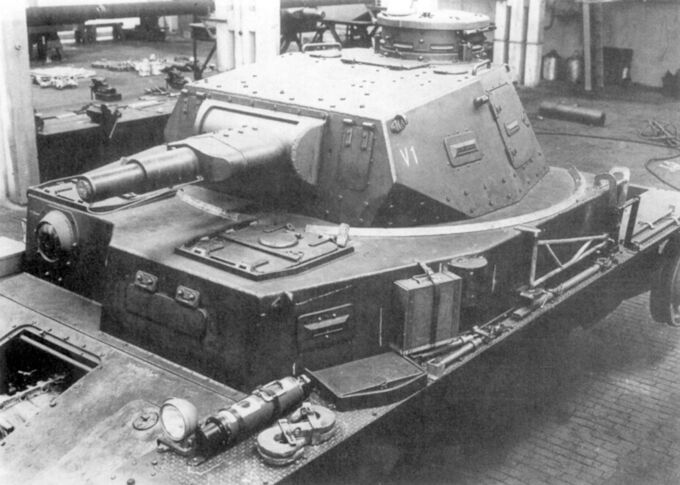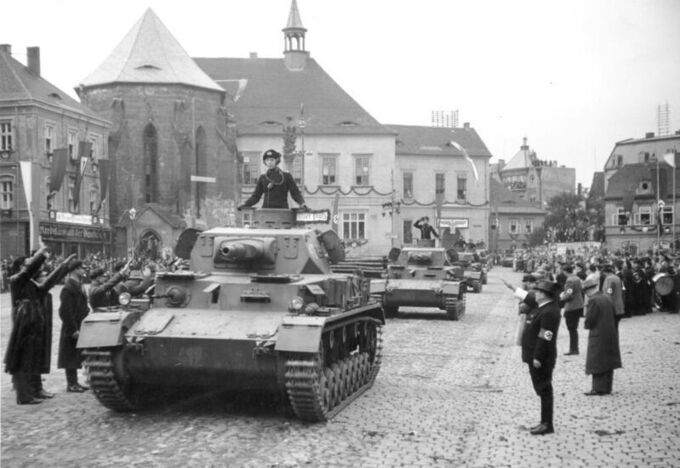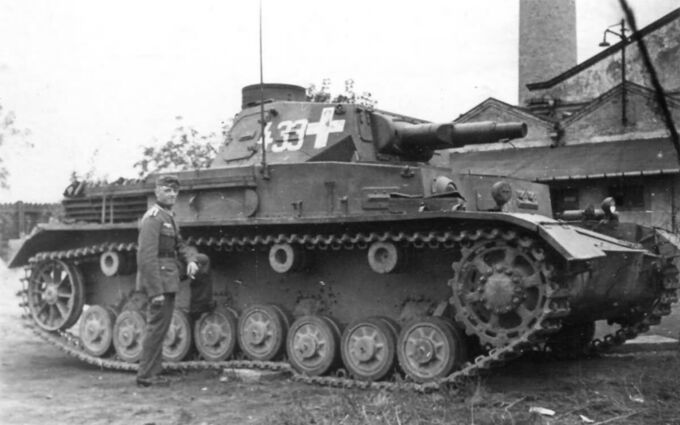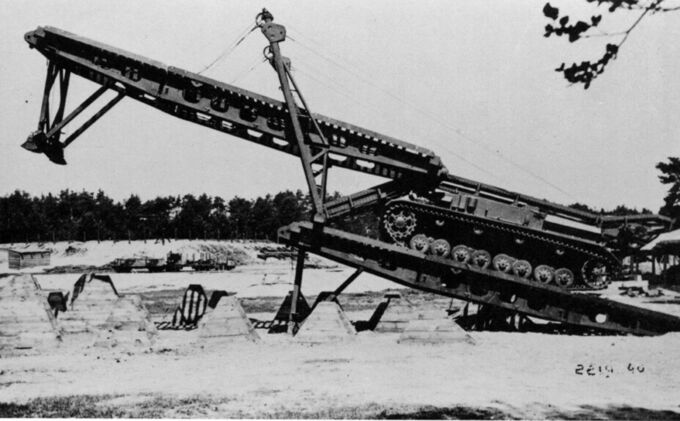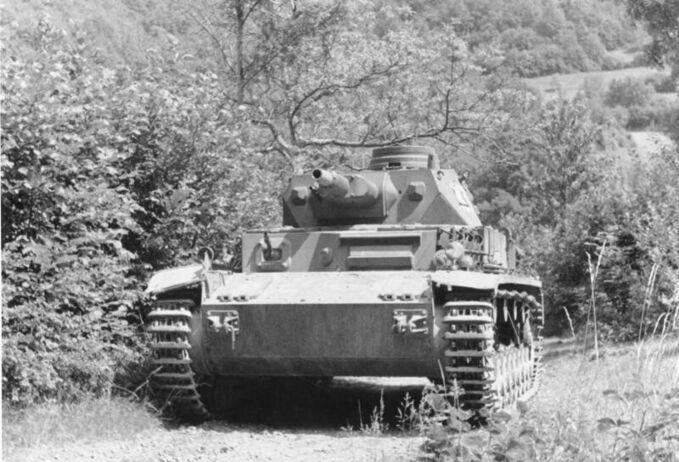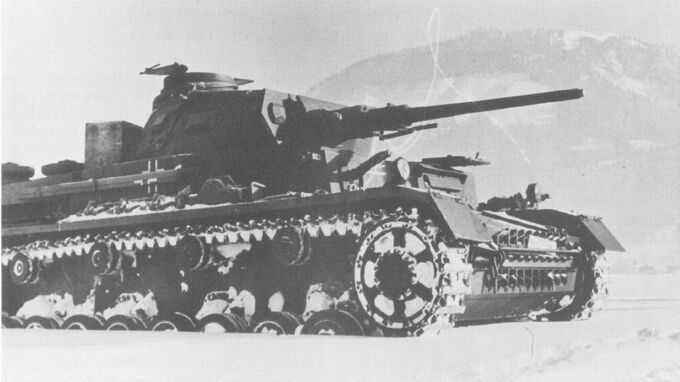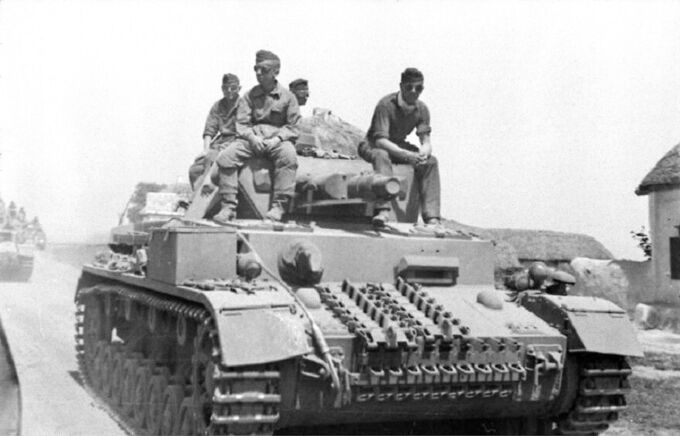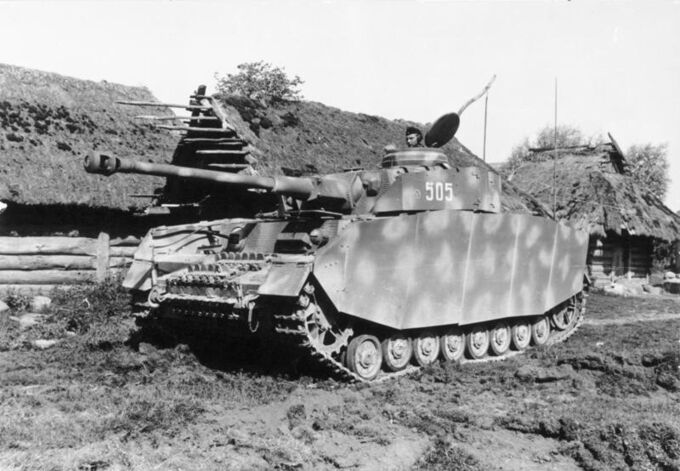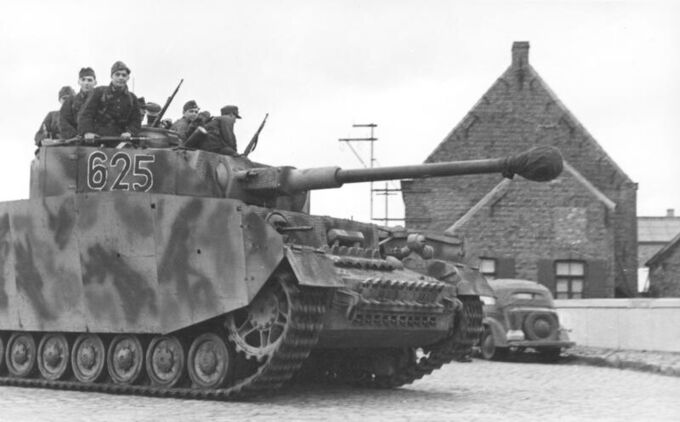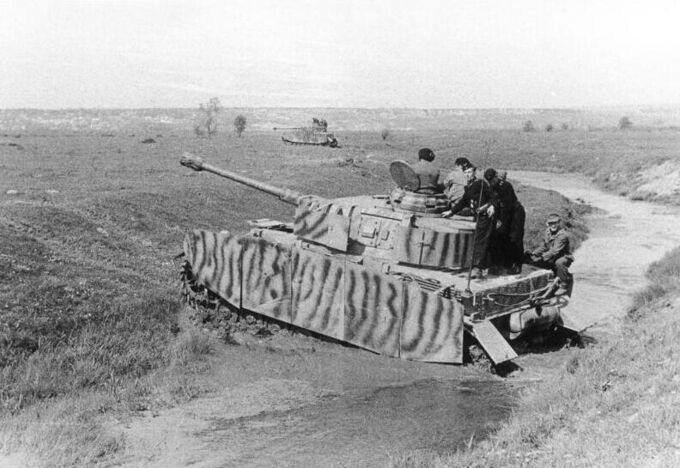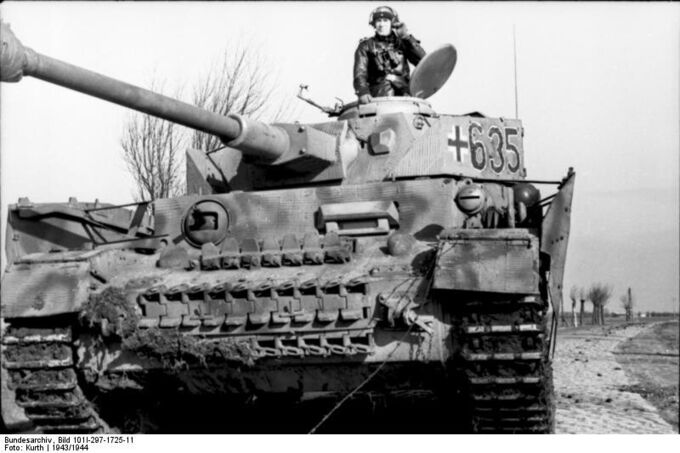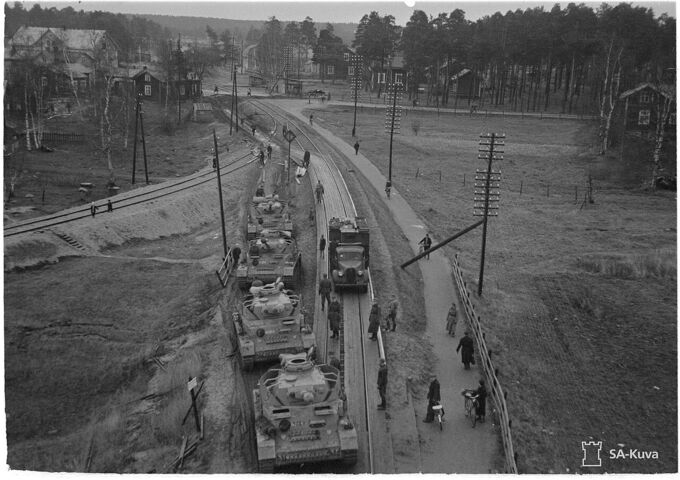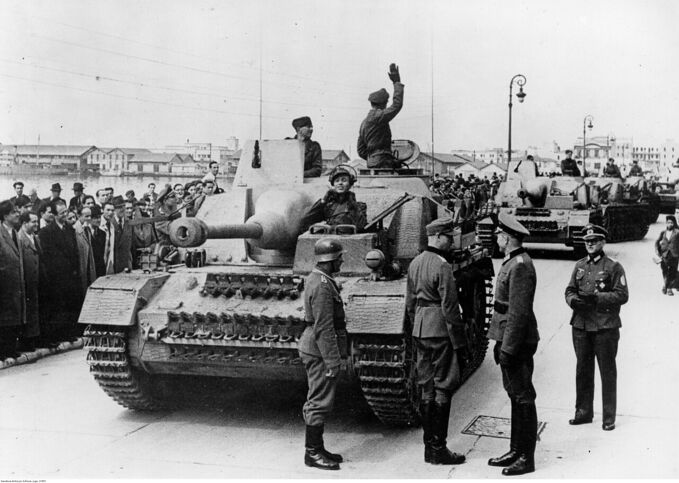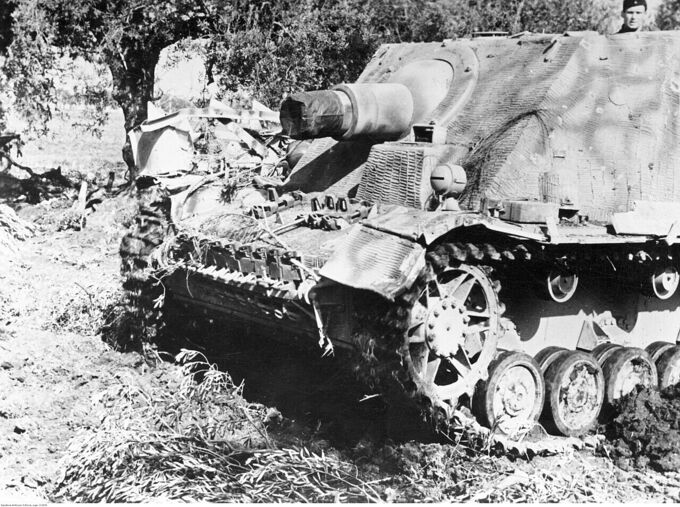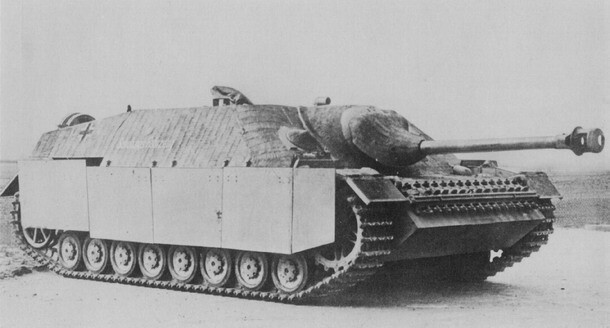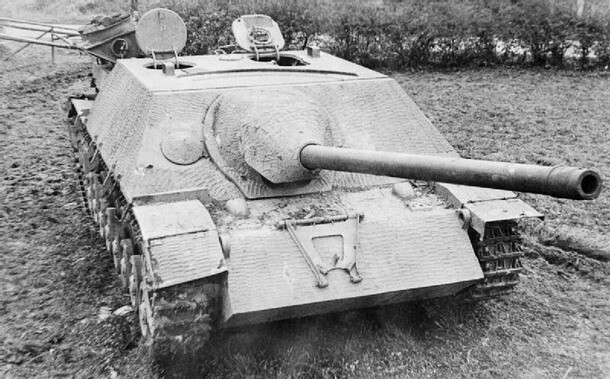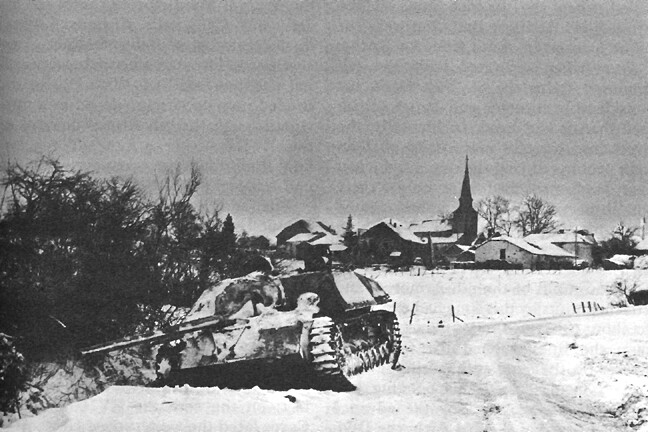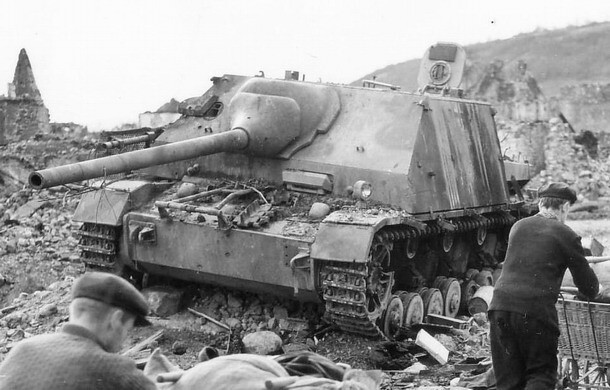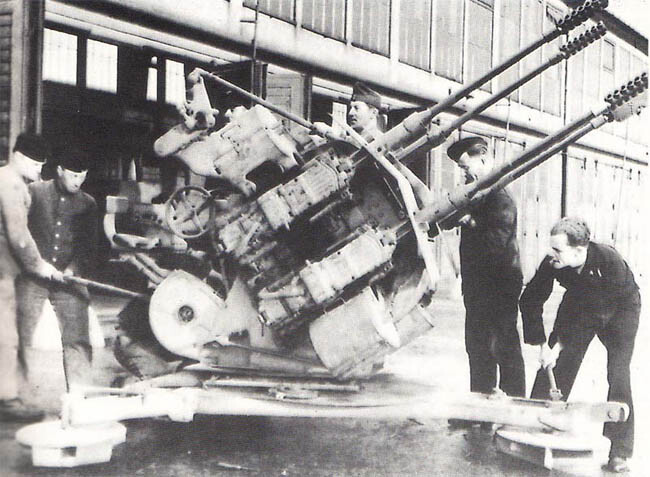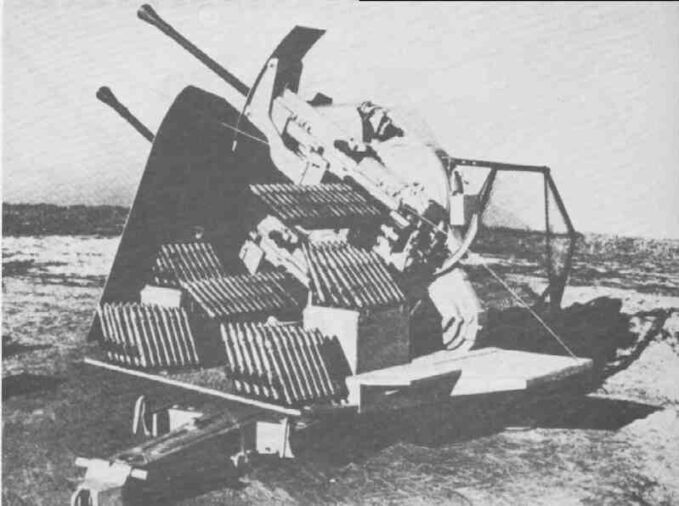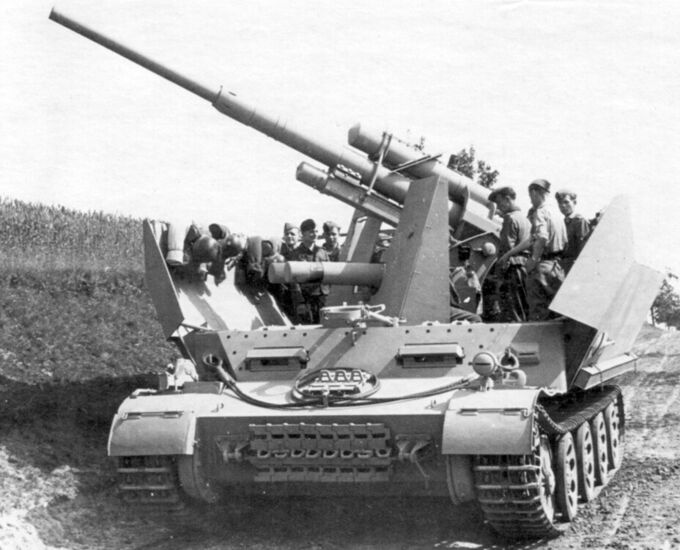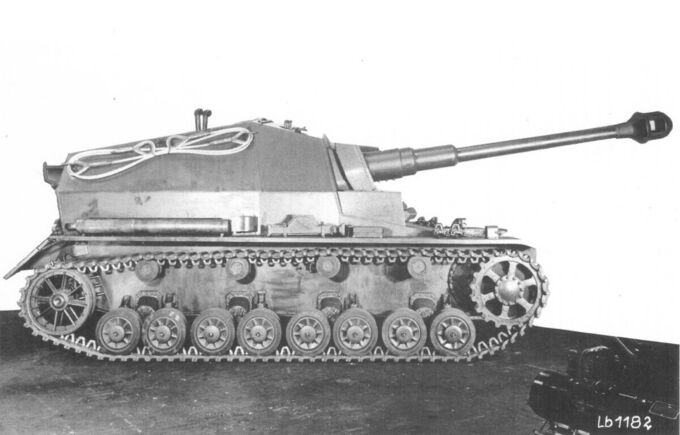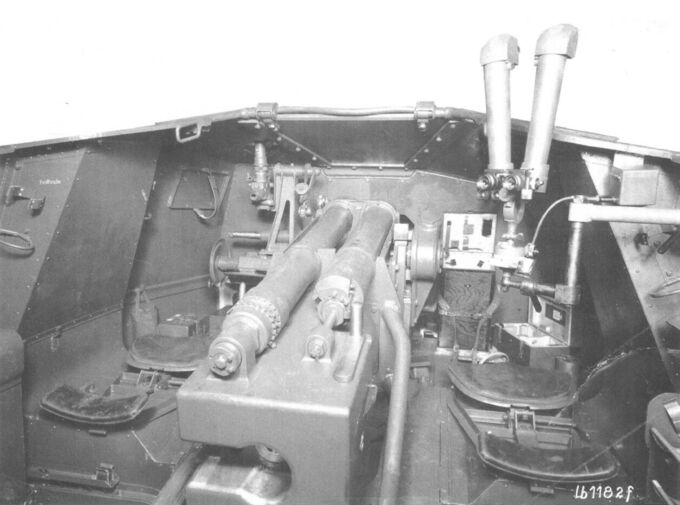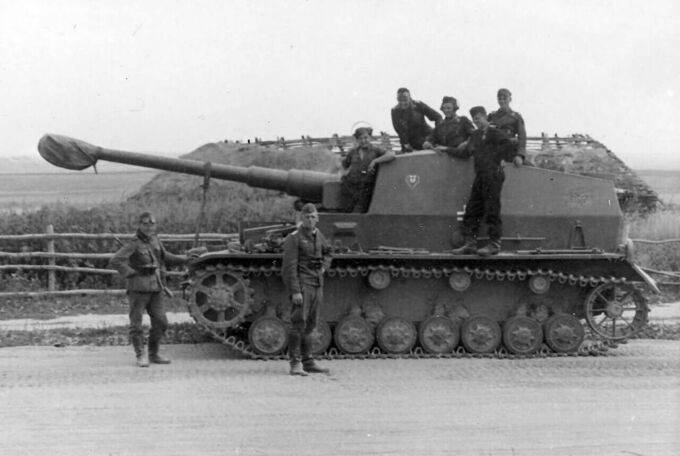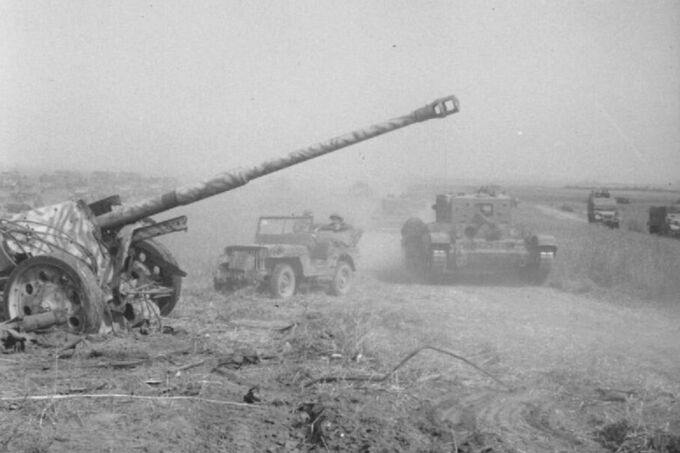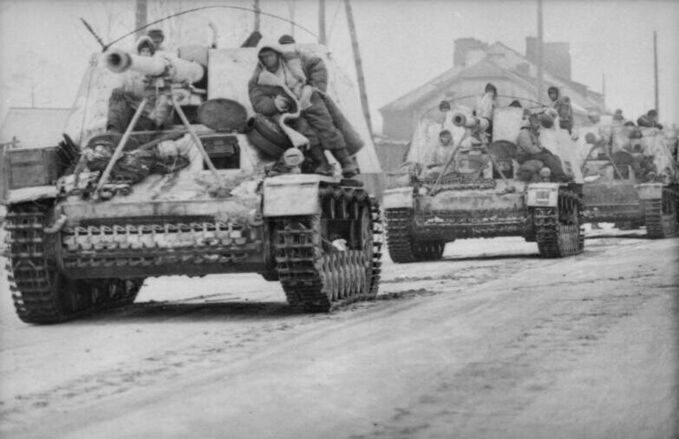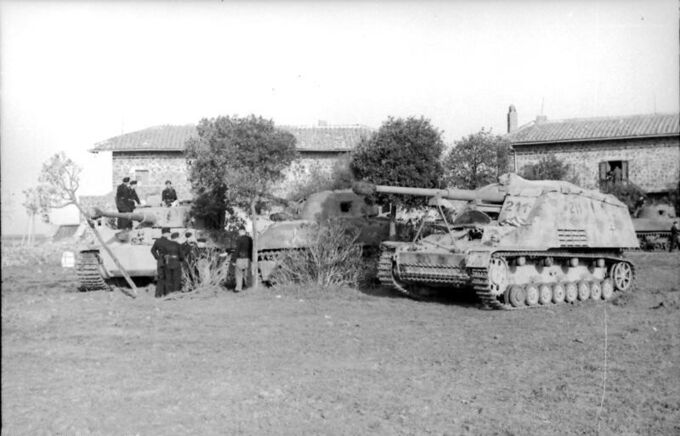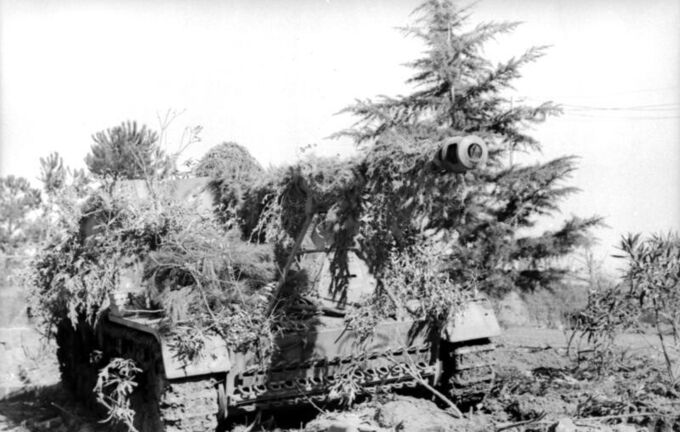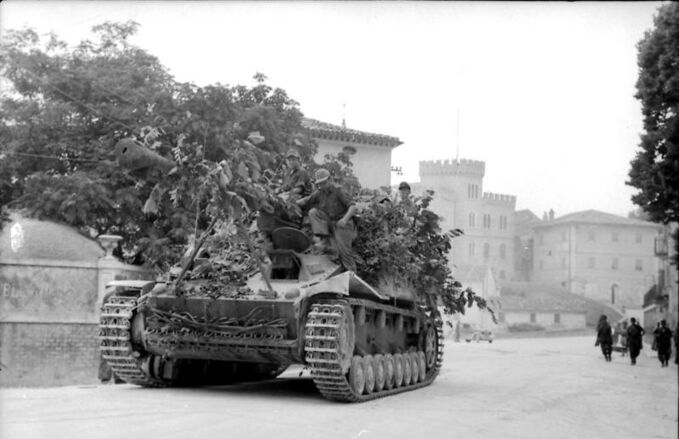This article will summarize the history of the German Panzerkampfwagen IV medium tank and its variants, including their development, production, and service history. The Pz.Kpfw. IV was one of the most produced fully tracked German armoured vehicles of the Second World War, second only to the Sturmgeschütz III assault gun. In addition to its original role as a medium tank, the chassis of the Pz.Kpfw. IV served as a versatile platform for many self-propelled weapon designs.
Early Development
Begleitwagen
Early German medium tank development during the late 1920s and early 1930s revealed significant issues in their design. Both the earlier Großtraktor and later Neubaufahrzeug suffered major drawbacks to their armour, armament, ammunition, and crew-carrying capabilities as a consequence of their engines. The aircraft engines chosen for both designs generated high amounts of torque at fairly low speeds, which necessitated heavier powertrain components to withstand the torque. Due to weight restrictions imposed to allow the vehicles to traverse bridges, other components of their design were severely limited. Additionally, the placement of the drive sprocket at the rear on both designs proved to be unsatisfactory. Both vehicles had the tendency to “throw” their tracks, where a track would become disengaged from the sprocket and other guiding wheels, resulting in a jam or the entire track coming loose.
Rheinmetall B.W.
To resolve these issues, a new medium tank design would employ engines designed by Maybach specifically for tanks, and incorporate a front-wheel drive. On the 26th of February 1935, a contract to design a new medium tank chassis was awarded to Rheinmetall. The project, first known as verbesserten Neubaufahrzeug, was later renamed to Begleitwagen, and was equipped with a Maybach HL 100 TR engine. The suspension of the Rheinmetall B.W. was adapted from that of the Neubaufahrzeug, which utilized coil springs. The Rheinmetall B.W. was ultimately rejected in favour of a competing design by Krupp, and only a wooden mock-up and a soft-steel trial chassis were produced.
Krupp B.W.
Nearly a year before Rheinmetall was officially awarded the design contract for the B.W., Krupp had begun a similar development of their own. On the 13th of April 1934, Krupp submitted a design for an 18-ton medium tank with leaf-spring suspension. The design would mount a 7.5 cm gun and coaxial machine gun in the turret, as well as a smaller turret mounting an unknown amount of machine guns in the right front of the superstructure. This secondary turret design was also used in the Rheinmetall B.W., and was likely derived from the Neubaufahrzeug. Further aspects of the design were finalized between Krupp and Waffen Prüfen 6—the design office of the German Heereswaffenamt—in November 1934, with the turret design based on that of the Zugführerwagen, another project at the time that would serve as the predecessor to the Pz.Kpfw. III.
In July 1935, a contract was awarded to Krupp for the construction of one B.W. I Kp. chassis, followed by a second contract in October 1935 for one B.W. II Kp. chassis. A final contract was awarded in January 1936 for the construction of turrets and superstructures for the B.W. Kp. in soft steel. Ultimately, both the B.W. I and II were completed in 1936, both vehicles replacing the secondary turret in favour of a ball-mounted machine gun in the superstructure. The B.W. I was completed with a turret and four pairs of roadwheels on each side, while the B.W. II was completed without a turret and with three pairs of larger road wheels per side. Neither design entered production, but both were later used to test torsion bar suspension and bridge-laying equipment.
Pz.Kpfw. IV and Variants
Pz.Kpfw. IV Ausf. A
Development and Production
In December 1936, Krupp was awarded a series of contracts for the construction of 35 vehicles of the Pz.Kpfw. IV as the 1.Serie/Begleitwagen, also known as the Ausf. A. Despite being visually similar to the B.W. I, including the roadwheel arrangement, many components of the Ausf. A were entirely different. Among the changes implemented on the Ausf. A, a more powerful Maybach HL 108 TR engine was installed, vision ports were taken from the Pz.Kpfw. II Ausf. A, the commander’s cupola was taken from the Pz.Kpfw. III Ausf. B. The armour of the Ausf. A reached a maximum thickness of 14.5 mm, which provided sufficient protection against 7.92 mm S.m.K. rounds. With five crew members, the Ausf. A was equipped with a 7.5 cm KwK 37 L/24 cannon and a coaxial 7.92 mm MG 34 machine gun in the turret, as well as a second MG 34 in a ball mount at the front of the superstructure. The Pz.Kpfw. IV Ausf. A through Ausf. C were given the inventory designation Vs.Kfz. 622, while succeeding variants were given the designation Sd.Kfz. 161.
The first two Ausf. A were produced and approved by inspectors from the Heereswaffenamt on the 30th of November 1937, and all 35 vehicles ordered were completed by June 1938. A number of changes were implemented in the production process—in December 1937, the number of 7.5 cm rounds carried was reduced from 140 to 122; and between May and June 1938, the final five Ausf. A were completed with the hull design of the succeeding Ausf. B with a thicker 30 mm frontal armour plate. The original design of the Ausf. A included an optional anti-aircraft machine gun mount on top of the turret, but this was also abandoned in February 1938 during the production process. Later modifications to the Ausf. A included the addition of smoke dischargers on the back of the hull in August 1938, tail lights in February 1940, the addition of 30 mm armour plates to the hull and superstructure of all vehicles in February 1941, and the addition of a stowage container on the back of the turret in March 1941.
Service History
German armoured doctrine during the pre-war and early war period dictated the use of the Pz.Kpfw. III and IV in tandem. While the Pz.Kpfw. III would serve as the vanguard, the Pz.Kpfw. IV was designed to fulfill a support role. Predominantly used to engage soft targets with high-explosive ammunition, the Pz.Kpfw. IV was nevertheless capable of engaging armoured targets with armour-piercing ammunition as well, though to a lesser degree of effectiveness. However, German armoured forces during early stages of the war were inadequately supplied with the more modern Pz.Kpfw. III and IV due to inefficiencies in German tank production. These vehicles were often supplemented by the Pz.Kpfw. I and II, as well as captured vehicles like the Pz.Kpfw. 35(t) and 38(t).
The Ausf. A participated in both the annexation of Austria and the Sudetenland before the war. Five Ausf. A were allocated for testing, while the remaining 30 formed part of the 211 Pz.Kpfw. IV used in the German invasion of Poland in September 1939. Of the 211 Pz.Kpfw. IV used, nearly 70 were damaged or out of action by the end of the campaign, due to mechanical issues and enemy fire. The Ausf. A was particularly vulnerable to the latter, due to its thin armour. The Ausf. A remained in service until the spring of 1941, when the surviving vehicles were relegated to training units.
Pz.Kpfw. IV Ausf. B, C
Development and Production
In October 1937, Krupp was awarded contracts to produce 42 vehicles of the Pz.Kpfw. IV as the 2.Serie/B.W., also known as the Ausf. B. The Ausf. B introduced several changes to the preceding Ausf. A design. The frontal armour was increased to a thickness of 30 mm, which was sufficient against 2 cm armour-piercing projectiles. The maximum speed was raised from 32 to 42 km/h through the introduction of a more powerful engine, the Maybach HL 120 TR. To save weight, the width of the superstructure was reduced, and the ammunition carrying capacity for the 7.5 cm gun was further reduced from 122 to 80. The driver’s vision port was modified, and the ball-mounted hull machine gun was replaced with a vision port for the assistant driver. Additionally, ridges were added which served to protect the turret ring from small-arms fire. The commander’s cupola was also changed, the new design taken from the Pz.Kpfw. III Ausf. C/D.
All 42 vehicles were completed between May and October 1938. The first 5 Ausf. B were completed with the armour specifications of the Ausf. A, while the final 30 were completed with the armour specifications of the Ausf. C. The same post-production modifications applied to the Ausf. A were applied to the Ausf. B as well.
The negligible changes between the Pz.Kpfw. IV Ausf. B and Ausf. C were the result of a series of events in the second half of 1937. In June 1937, Krupp was ordered by Waffen Prüfen 6 to discontinue any further development efforts on the chassis of the B.W. after the Ausf. B finished production. Waffen Prüfen 6 had originally intended to implement standardization across the Pz.Kpfw. III and IV, by mandating that further Pz.Kpfw. IV variants be built on the 4.Serie/Z.W. (Pz.Kpfw. III Ausf. E) chassis, which was still under development at the time. Constant delays in the development of the 4./Z.W. chassis ultimately necessitated the assembly of further Pz.Kpfw. IV before a significant gap appeared in production.
In October 1937, Krupp was ordered to produce 140 vehicles of the Pz.Kpfw. IV as the 3.Serie/B.W., also known as the Ausf. C. Due to the ban on any further development of the B.W. project, the Ausf. C was nearly identical to the Ausf. B. The main change between the Ausf. B and C was the addition of an armoured sleeve to protect the protruding barrel of the co-axial machine gun. Between October 1938 and August 1939, 134 Ausf. C were produced, while the remaining six from the order were allocated to be built as Brückenleger IV bridge-laying vehicles in June 1939. However, three of these would ultimately be rebuilt with Ausf. C turrets on Ausf. E superstructures between July and August 1940.
A number of changes were implemented in the production process—from the 31st turret onwards, the commander’s cupola was taken from the Pz.Kpfw. III Ausf. E instead; after the 40th chassis, the improved Maybach HL 120 TRM engine was used; and, after the 57th superstructure, rain guards were welded above the driver’s vision port. The same post-production modifications applied to the Ausf. B were applied to the Ausf. C as well.
Service History
Both the Ausf. B and C were part of the 211 Pz.Kpfw. IV that participated in the invasion of Poland in September 1939. Both variants continued to serve in German operations in Western Europe in May 1940, where the nearly 300 Pz.Kpfw. IV struggled against heavier Allied armour, especially the French Char B1 heavy tank. Serving in the German invasions of Yugoslavia, Greece, and the Soviet Union, the Ausf. B and C remained in active service until 1943, when attrition and diminishing numbers forced the remaining Ausf. B and C into training roles. During the Allied invasion of Western Europe in June 1944, some Ausf. B and C were returned to active service to replenish armoured units, where they saw limited action until August 1944.
Pz.Kpfw. IV Ausf. D
Development and Production
In July 1938, Krupp was ordered to produce 200 Pz.Kpfw. IV as the 4.Serie/B.W., which was followed by 48 as the 5.Serie/B.W. sometime between November and December 1938. Despite having different series numbers, both were the same variant, being the Ausf. D. With the Ausf. D, the armour thickness of the sides and rear was increased to 20 mm. The ball-mounted hull machine gun was reintroduced, and a new, thicker external mantlet for the main gun was also added.
Of the 248 ordered, 232 were completed between October 1939 and October 1940, with 16 of the chassis being allocated as Brückenleger IV. Beginning in July 1940, an additional 30 mm armour plate was added to the front of the superstructure and hull, while the final 68 vehicles were completed with thicker 50 mm frontal armour. The same post-production modifications applied to the Ausf. B were applied to the Ausf. D as well. In July and August 1940, 48 Ausf. D were converted to Tauchpanzer submersible tanks in preparation for the German invasion of England, which ultimately did not occur. Tropical modifications—including additional ventilation and faster fans—were made to approximately 30 vehicles for service in North Africa during 1941, and surviving Ausf. D were refitted with the long-barreled 7.5 cm KwK 40 in July 1942.
In 1941, a single Ausf. D (chassis number 80668) was fitted with a 5 cm KwK 39 L/60 as part of an experiment to enhance the vehicle’s capabilities against enemy armour. No further examples were produced.
Service History
Owing to its late introduction, the Ausf. D did not see service in the German invasion of Poland. The Ausf. D first saw action in Western Europe in May 1940. Of the 40 Pz.Kpfw. IV serving in North Africa in 1941, the majority were the Ausf. D variant. Combat attrition reduced the number of operational Pz.Kpfw. IV to 10 by early 1942, when the remaining Ausf. D were replaced by later models due to their insufficient armament. The Ausf. D continued to serve in German operations in the Balkans as well as the Soviet Union. The Ausf. D remained in service until the end of the war, with some vehicles allocated to training duties.
Pz.Kpfw. IV Ausf. E
Development and Production
In March 1938, plans were made to award a contract to Krupp for the production of 80 Pz.Kpfw. IV as the 5.Serie/B.W., also known as the Ausf. E. The production number was increased to 223 in July of the same year. When the series number 5 was used for the Ausf. D in late 1938, the series designation was changed to 6. Krupp was ordered to produce 223 Pz.Kpfw. IV as the 6./B.W. in July 1939, though this number was reduced to 206 in March 1941. Plans were made to increase the frontal armour of the Ausf. E to 50 mm after German armoured forces encountered Polish 3.7 cm anti-tank guns in 1939, but these were implemented too late in July 1940. As a result, the Ausf. E was reinforced with 30 mm plates instead, as with the other Pz.Kpfw. IV variants before it. The commander’s cupola was taken from the Pz.Kpfw. III Ausf. G, and shifted forward to eliminate the protrusion on the back of the turret.
Of the 206 ordered, 200 were completed between October 1940 and April 1941. Four of the remaining six chassis were allocated as Brückenleger IVc bridge-layers, while the other two were used to test the Schachtellaufwerk, an interleaving roadwheel and suspension arrangement similar to that used on the later Pz.Kpfw. V Panther and Pz.Kpfw. VI Tiger tanks. The majority of the Ausf. E were produced without the supplemental 30 mm armour plates on the front of the superstructure. Approximately 10 Ausf. E were given tropical modifications for service in North Africa in 1941, and an unknown number were converted to Tauchpanzer in the same year. Other post-production modifications included the addition of the missing supplemental armour plates. All surviving Ausf. E were refitted with the 7.5 cm KwK 40 in July 1942.
Service History
The Ausf. E served in Yugoslavia and Greece in April 1941, with a small number also deployed in North Africa between 1941 and 1942. In the Soviet Union, the Ausf. E encountered similar challenges as earlier Pz.Kpfw. IV variants. As with other short-barreled Pz.Kpfw. IV variants, the 7.5 cm cannon proved effective against lighter Soviet tanks, such as the T-26 and BT series, but struggled against the T-34 and KV series. The Ausf. E remained in active service until early 1944.
Pz.Kpfw. IV Ausf. F (F1)
Development and Production
Krupp was originally requested to produce 128 Pz.Kpfw. IV as the 7.Serie/B.W. in December 1938, which was increased to 500 in November 1939 following the start of the war. In June 1940, a further 100 vehicles were each ordered from two other assembly plants, Vomag and Nibelungenwerk. In January 1941, another 300 were ordered from Krupp. The Ausf. F introduced the 50 mm frontal armour originally planned for the Ausf. E, and increased the side armour thickness to 30 mm. Some automotive modifications were made to accommodate the increased weight of the armour. Additionally, a new driver’s vision port and ball mount for the hull machine gun were added on the Ausf. F, and the gun mantlet was thickened to 50 mm.
Between April 1941 and February 1942, Krupp completed 393, Vomag 64, and Nibelungenwerk 13 vehicles. In February 1942, production of the Ausf. F shifted to fitting the vehicle with the long-barreled 7.5 cm KwK 40 L/43. Some Ausf. F chassis, along with other variants, were used for various experiments and modifications. Most notably, a handful of Pz.Kpfw. IV chassis were used as Munitions-Schlepper for the self-propelled Karl-Gerät siege mortars. Modifications during production included the addition of a tow hitch for fuel trailers during April 1941, the removal of rear-mounted smoke grenades in February 1942, and the addition of 20 mm spaced armour, known as Vorpanzer, to the front of the turret and superstructure in the same month. Post-production modifications on the Ausf. F included the addition of tow hitches for all vehicles in July 1941, the refitting of vehicles with the 7.5 cm KwK 40 in July 1942, the addition of coolant heaters in September 1942, and equipping Wintergleisketten track modifications in November 1942.
Service History
Small numbers of the Ausf. F saw only limited service in North Africa between 1941 and 1942, as the predominant tank used by the Germans in the theatre was the Pz.Kpfw. III. The Ausf. F performed similarly in the Soviet Union to the preceding variants of the Pz.Kpfw. IV on account of its identical armament. The 50 mm armour plating provided more effective protection against Soviet 45 mm cannons, though it was still vulnerable to 76 mm fire. The number of Pz.Kpfw. IV in operation reduced greatly from 1941 to 1943, due to enemy action and mechanical issues from harsh weather. Some Ausf. F were used in Yugoslavia against partisans until the end of the war.
Pz.Kpfw. IV Ausf. G (F2/G)
Development and Production
The shift in Pz.Kpfw. IV Ausf. F production to mounting the 7.5 cm KwK 40 L/43 resulted in a series of designation changes in early 1942.
- 13 January 1942 — 7./B.W.-Umbau
- 3 March 1942 - Pz.Kpfw. IV Ausf. F-Umbau
- 21 March 1942 — Pz.Kpfw. IV Ausf. F2 (7.5 cm KwK 40) (7./B.W.-Umbau)
- 22 May 1942 — Pz.Kpfw. IV Ausf. F2 (7.5 cm KwK 40) (7./B.W.)
- 5 June 1942 — Pz.Kpfw. IV Ausf. G (8./B.W.)
When the vehicle’s designation changed on the 21st of March 1942 to Ausf. F2, the original short-barreled Ausf. F was redesignated as Ausf. F1. On the 1st of July 1942, Waffen Prüfen 6 finalized the designations, replacing Ausf. F1 (7./B.W.) with Ausf. F (7./B.W.) and Ausf. F2 (7./B.W.) with Ausf. G (8./B.W.). This has led to confusion in differentiating between the Ausf. F1, F2 and G. Ultimately, the designation Ausf. F1 and F2 were only briefly used, between the 21st of March and the 1st of July 1942—the F1 being the Ausf. F mounting the KwK 37, and the F2 being the Ausf. F (ordered as 7./B.W.) mounting the KwK 40. The Ausf. F2 was then incorporated as part of the later Ausf. G (the later 8./B.W. production contract) due to their negligible differences. This decision redesignated the remaining 7./B.W. in production as the 8./B.W. (Ausf. G). The Pz.Kpfw. IV Ausf. G received the new ordnance inventory designation Sd.Kfz. 161/1.
An additional 1,400 Pz.Kpfw. IV were separately ordered as the 8./B.W. between June 1941 and February 1942. The differences between the Ausf. F and G at the start of the latter’s production were entirely due to their armament—modifications were required to accommodate the longer cannon.
Between March 1942 and June 1943, Krupp completed 907, Vomag 436, and Nibelungenwerk 587 Ausf. G, with several changes being made throughout its production. Racks for spare roadwheels and track links were added in June 1942; 30 mm Zusatzpanzer supplementary armour were added to the front of the hull and superstructure to a handful of vehicles in May and June 1942, half of all production vehicles in November 1942, and all production vehicles in January 1943; smoke grenade launchers on both sides of the turret were adopted at the start of production, but later abandoned in May 1942; the commander’s cupola was replaced by a new design using a single-piece hatch in February 1943; the 7.5 cm KwK 40 L/43 was replaced by the longer L/48 in April 1943; and, the installation of Schürzen armoured panels to protect against Soviet anti-tank fire in the same month.
Major post-production modifications included the fitting of Wintergleisketten in November 1942, the installation of Schürzen to all vehicles in May 1943, the application of Zimmerit anti-magnetic paste in January 1944, and the fitting of Ostketten on Eastern Front vehicles in May 1944.
Service History
The Ausf. G was introduced throughout 1942 and remained in service until the end of the war. Up to 30 Ausf. G saw action in North Africa between May 1942 and May 1943, demonstrating a high level of effectiveness against the lighter Allied armour used in the theatre. The Ausf. G was found to be similarly effective on the Eastern Front, as the KwK 40 was capable of effectively engaging both the T-34 and KV series. After the introduction of the Ausf. H and J in 1943, records become vague in regards to the service history of individual Pz.Kpfw. IV variants, simply referring to all variants as the “Pz.Kpfw. IV”. The Pz.Kpfw. IV mainly served on the Eastern Front, though nearly 800 vehicles were each deployed to Italy and Western Europe between 1943 and 1944.
Pz.Kpfw. IV Ausf. H
Development and Production
A series of changes were initially planned for the Pz.Kpfw. IV as the 9.Series/B.W., known as the Ausf. H. This included a narrow turret design known as the B.W. 40, a hydraulic—instead of the originally electric—turret drive, new gun sights, and submersible capabilities. These requirements were dropped in July 1942, though a decision was made in December 1942 to implement another drastic set of changes to the Pz.Kpfw. IV. This proposed a sloped 50 mm front plate, sloped side armour, reinforced roof and underside armour, wider tracks, and reinforced roadwheels, bringing the vehicle’s weight to 28 tons. These were eventually dropped on the 17th of February 1943, as the steering unit was originally designed for an 18-ton vehicle, and the weight of the new design exceeded its limitations.
Ultimately, only two modifications were applied between the Ausf. G and H. This included the reinforcement of the final drive, which lowered the maximum speed of the vehicle to 38 km/h, and the reinforcement of the vehicle’s roof armour by up to 15 mm in some parts. The Pz.Kpfw. IV Ausf. H received the new ordnance inventory designation Sd.Kfz. 161/2.
Over the course of multiple contracts, Krupp was ordered to build 1,400 Pz.Kpfw. IV as the 9./B.W., known as the Ausf. H, Vomag was ordered to build 1,200, and Nibelungenwerk was ordered to build 2,400. Many contracts were not entirely fulfilled due to changes in requirements. Between May 1943 and February 1944, 2,322 Ausf. H were produced, with 379 from Krupp, 693 from Vomag, and 1,250 from Nibelungenwerk. In total, an additional 90 Ausf. H chassis from Nibelungenwerk were used in the production of other vehicles, including 60 for the Sturmpanzer IV and 30 for the Sturmgeschütz IV.
Several changes were made during the production of the Ausf. H. Notably, the frontal armour thickness was increased to 80 mm in June 1943, Zimmerit was applied in September 1943, and the return rollers and idler wheel were reinforced in October 1943. Additionally, post-production modifications included those implemented on the Ausf. G, and included the addition of a coupling for tow bars on the back of the hull in December 1944. From the Ausf. H onwards, an optional anti-aircraft mount attached to the commander’s cupola became available for the Pz.Kpfw. IV, though it only saw limited use.
Service History
Given the general similarity between later variants of the Pz.Kpfw. IV, it becomes increasingly difficult in late stages of the war to determine the exact service history of each variant. Complicating the issue, vehicles sent for repair or modified over time would often receive a combination of modifications from different variants, resulting in a nondescript mixture of components in each vehicle. The Ausf. H entered service in May 1943, and remained in service until the end of the war. On the Eastern Front, the Ausf. H participated in major engagements, including Operation Citadel in 1943. A significant amount of Pz.Kpfw. IV were deployed in Italy during the same time, as well as in Western Europe. These units participated in fighting against Allied forces in the West from the Normandy landings in June 1944 to the end of the war.
Pz.Kpfw. IV Ausf. J
Development and Production
The final variant of the Pz.Kpfw. IV was the 10./B.W., also known as the Ausf. J. The letter 'I' was excluded from Ausführung designations to avoid confusion with the Roman numeral. German armoured production during late stages of the war suffered from setbacks due to Allied bombing raids, and various changes were made to concentrate production away from the Pz.Kpfw. IV. A series of directives issued in late 1943 resulted in Krupp shifting all production efforts away from the Pz.Kpfw. IV by the time of the Ausf. J.
Production of the Ausf. J began in February 1944. After producing 180 Ausf. J, Vomag gradually shifted production to the Jagdpanzer IV, ending all Pz.Kpfw. IV production by June 1944. While multiple attempts were made to replace Pz.Kpfw. IV production at Nibelungenwerk with more effective designs for the late war period, production ultimately continued through to the end of the war. Before April 1945, Nibelungenwerk produced 2,980 Ausf. J, while another 15 were produced during the last month of the war. Even weeks after the end of the war in Europe, Nibelungenwerk produced nearly 30 Ausf. J under Soviet control. An additional 172 Ausf. J chassis were assembled by Nibelungenwerk for the production of Sturmpanzer IV.
The main modification between the Ausf. H and J was the replacement of the electric turret drive with a hand-powered traverse, which offered improved efficiency when traversing the turret on sloped ground. The removal of the auxiliary generator required for the electric drive provided space for an additional 200-litre fuel tank. Due to delays and faulty components, the additional fuel tank was only installed in production vehicles between July and August 1944, as well as from September 1944 to the end of the war.
The Ausf. J received multiple changes during production. This included the removal of vision ports on the turret side hatches in May 1944; the replacement of C-shaped tow hooks with S-shaped hooks in June 1944; the reinforcement of roof armour on the superstructure to 16 mm in July 1944; a new flame-hiding Flammentöter muffler in August 1944; the discontinuation of Zimmerit in September 1944; the use of wire-mesh Schürzen instead of solid plates in the same month; the adoption of a pivoting hatch for the commander’s cupola in October 1944; and, the reduction in return rollers to three on each side in December 1944. Post-production modifications included those introduced on the Ausf. G and H.
Service History
The Ausf. J entered service in March 1944 and first saw action on the Eastern Front. It represented a significant portion of the 863 Pz.Kpfw. IV deployed in France to defend against Allied forces in June 1944. In comparison with the StuG, the Pz.Kpfw. IV was found to be more effective in the terrain of Italy and France due to the higher mounting of its gun and its traversable turret. Another 260 Ausf. J were deployed on the Western Front during the winter of 1944 as part of the German offensive through the Ardennes. Although enemy fire contributed to the loss of many Pz.Kpfw. IV during the offensive, the majority of Pz.Kpfw. IV were rendered inoperable due to lack of fuel and parts. While the Pz.Kpfw. IV had less armour and armament compared to heavier German vehicles used in the offensive, it remained a crucial asset due to its more efficient fuel consumption. The Ausf. J continued to serve until the end of the war.
Pz.Bef.Wg. IV Ausf. J
Conversions of Pz.Kpfw. IV to Panzerbefehlswagen command vehicles began in March 1944, with 88 vehicles converted by July 1944. An additional 17 Pz.Bef.Wg were built on the Pz.Kpfw. IV Ausf. J chassis between August and September 1944. While specific records end by 1945, there is evidence suggesting continued production into 1945. To accommodate additional radio equipment on converted vehicles, the number of 7.5 cm ammunition carried was reduced to 72 rounds. Two models of command vehicle were built—the Sd.Kfz. 267 for long-range ground communications, and the Sd.Kfz. 268 for communications with aircraft. Both vehicles were equipped with the Fu 5 radio set, which used a 2 meter antenna on the turret roof. The Sd.Kfz. 267 was equipped with the Fu 8 radio, which a Sternantenne D “star” antenna on the back of the hull. The Sd.Kfz. 268 was equipped with the Fu 7 ground-to-air radio, which used a 1.4 meter antenna mounted on the rear.
Bergepanzerwagen IV
Between October 1944 and March 1945, 21 Pz.Kpfw. IV were converted into Bergepanzerwagen IV armoured recovery vehicles. There are no surviving photographs of this vehicle, which is only known through wartime records. The conversion involved removing the turret, covering the turret ring with wooden planks and a hinged hatch, adding a bracket for a wooden un-ditching beam, and installing a crane with towing bars. The vehicle’s lack of a winch significantly impacted its effectiveness as a recovery vehicle. Though the addition of a powered winch was initially planned, the modifications were never made.
Pz.Beob.Wg. IV
Development and Production
In September 1943, arrangements were made to convert Pz.Kpfw. IV into artillery observation vehicles known as Panzerbeobachtungswagen. This conversion process added plotting equipment for the artillery observer and replaced the commander’s cupola with a cupola adopted from the StuG. While the cupola of the Pz.Kpfw. IV used vision slots, the cupola of the StuG used periscopes, which were better suited for spotting duties. Two long-range radio sets—the Fu 8 and Fu 4—and a third short-range radio set—the Fu.Spr.f—were installed in the vehicle to facilitate communication with self-propelled artillery batteries, and power was provided by an electrical generator installed in the fighting compartment. The coaxial machine gun was removed to accommodate the communications equipment, though the 7.5 cm KwK remained fully useable.
With the first experimental Pz.Beob.Wg. IV completed in January 1944, conversions to the observation variant began on every 25th Pz.Kpfw. IV Ausf. J produced after April 1944. Between April 1944 and February 1945, 203 vehicles were converted to Pz.Beob.Wg. IV, though delays resulted in only 140 vehicles being approved by inspectors by March 1945. As with the Pz.Kpfw. IV Ausf. J, the application of Zimmerit on the Pz.Beob.Wg. IV ceased after September 1944.
Service History
Pz.Beob.Wg. IV were issued to seven armoured divisions on the Western Front for the Ardennes offensive, while many others were issued to units on the Eastern Front. Artillery observation vehicles were often deployed with other vehicles of a similar model to prevent being targeted by enemy fire. The Pz.Beob.Wg. IV was ill-suited for direct combat despite carrying the 7.5 cm KwK, as it was required for its primary purpose of artillery observation during any engagements. More often than not, the 7.5 cm KwK served as an impediment by occupying a significant amount of space inside the turret.
Foreign Users of the Pz.Kpfw. IV
Finland
In 1944, Finland purchased 20 early-production Pz.Kpfw. IV Ausf. J, while an order for 40 more vehicles was ultimately not fulfilled. In August 1944, Finland only received 15 of the 20 vehicles ordered before hostilities ended with the Soviet Union in September. The Ausf. J later served in the Lapland War between Finland and Germany until the end of April 1945. After the war, the Ausf. J was relegated to training duties until it was entirely withdrawn from service in 1955.
Italy
Italy initially requested to produce the Pz.Kpfw. IV under license in 1942, but this plan was never realized. Instead, Germany delivered 12 Pz.Kpfw. IV Ausf. G to Italy in 1943. However, training issues and the Italian armistice resulted in these vehicles returning to Germany without having seen any combat in Italian service.
Bulgaria
Between February 1943 and February 1944, 88 Pz.Kpfw. IV were delivered to Bulgaria, of which 14 were Ausf. G. When Bulgaria joined the Allies in September 1944, many of the previously supplied Pz.Kpfw. IV were destroyed in action against German forces. Throughout early 1945, a further 20 captured Pz.Kpfw. IV were supplied to Bulgaria from the Soviet Union. With the addition of 28 vehicles built by Nibelungenwerk under Soviet control in late 1945, 102 Pz.Kpfw. IV remained in service with Bulgaria by December 1945. Many vehicles were later repurposed as static defenses in fortifications.
Other Nations
In November 1943, 20 Pz.Kpfw. IV Ausf. H were supplied to Spain. Between November 1943 and August 1944, 127 Pz.Kpfw. IV were delivered to Romania. In the post-war period, France operated more than 60 captured Pz.Kpfw. IV. Nearly 200 Pz.Kpfw. IV were abandoned in Czechoslovakia at the end of the war. A portion of these vehicles were operated by Czechoslovakia, while the remainder were exported to Syria.
Sturmgeschütz and Jagdpanzer
Sturmgeschütz IV
Development and Production
In February 1943, an initial proposal was made to Krupp to mount the StuG superstructure on a Pz.Kpfw. IV chassis. The chassis was to be taken from the newly designed 9./B.W., featuring sloped armour and wider tracks. The proposal was later abandoned when it was found that the vehicle suffered from similar weight issues as the original 9./B.W. design. The idea was hastily revived after Allied bombing destroyed Alkett’s StuG production facilities in late November 1943.
To expedite conversion, it was decided to mount the superstructure on a standard Pz.Kpfw. IV chassis. The front of the superstructure was extended to fit the longer hull, with gaps in the armour filled with additional plating. The armament of the vehicle was identical to the StuG III, with a 7.5 cm Sturmkanone 40 main gun and a secondary MG 34/42 machine gun. The machine gun could be mounted conventionally on top of the superstructure, or in a remote-controlled Rundumsfeuer mount, capable of traversing 360 degrees. The new vehicle was designated as the Sturmgeschütz IV, with the ordnance inventory designation Sd.Kfz. 167.
The first 30 Pz.Kpfw. IV chassis were sent from Nibelungenwerk to Alkett for conversion, which began in January 1944. Production at Krupp was quickly shifted to the StuG IV as well, with 30 vehicles produced by December 1944. Between December 1943 and the end of the war, 1,143 StuG IV were produced. Modifications made to the Pz.Kpfw. IV Ausf. H and J were also applied to the StuG IV, including the installation of Flammentöter mufflers in August 1944; the addition of a bracket for towing bars in December 1944; and, the reduction of return rollers to three on each side in the same month. Similarly, modifications made to the StuG III were applied to the StuG IV, including the installation of an angled 30 mm armour plate in front of the driver’s compartment; the simplification of the driver’s hatch; and, the installation of a travel lock for the main gun.
Service History
Entering service in 1944, the StuG IV was organized into units with the StuG III and first saw action on the Eastern Front. Due to the similarities between the StuG III and IV, combat records often did not differentiate between them. While the StuG was primarily deployed with infantry units, some vehicles were also assigned to armoured units. The main armament of the StuG continued to be effective in the anti-armour role throughout the final years of the war, both on the Eastern and Western Fronts. Some vehicles were deployed in Italy and the Balkans from 1944 to 1945. The StuG IV was used in some of the final engagements of the war in Europe, including the defense of Berlin in April 1945. More than 250 vehicles were still operational across all fronts by the end of the war, many of which were captured by Allied forces.
Sturmpanzer IV
Development and Production
In 1942, Alkett was ordered to begin the development of a Sturmgeschütz based on the Pz.Kpfw. IV chassis. This vehicle would carry the Škoda-designed 15 cm Sturmhaubitze 43 L/12, which was purpose-built for armoured vehicles. On the 2nd of October 1942, Hitler ordered that production of 40 to 60 vehicles begin by the spring of 1943 to address the need for Sturmgeschütz at the time. Two weeks later, Hitler also ordered the development of a thin-walled shell with a larger explosive capacity for the demolition of structures.
Using experience gained from previous assault gun designs, Alkett developed a superstructure largely using existing parts. The superstructure had 100 mm of sloped frontal armour, with sloped armour also used on the sides and roof. Škoda was tasked with designing a ball-socket mount for the StuH. Generaloberst Heinz Guderian persuaded Hitler to classify the vehicle as a Panzerjäger to organize it with armoured units instead of artillery, a decision which was made on the 11th of April 1943. On the 4th of May 1943, the vehicle was redesignated as the Sturmpanzer IV, with the ordnance designation Sd.Kfz. 166. German troops used the contraction Stupa of the designation as a nickname for the vehicle. While the name Brummbär is often used in reference to this vehicle, the name was never recorded in any official German documents. Throughout the war, the name exclusively appeared in Allied intelligence reports, though its origin remains unknown.
A wooden mock-up of the vehicle was completed in February 1943, and 60 production vehicles soon followed starting in April 1943. Early series of the Sturmpanzer were not produced in a dedicated assembly plant. Instead, rebuilt Pz.Kpfw. IV chassis were converted into Sturmpanzer in a vehicle repair depot in Vienna. The first 60 vehicles were completed by May 1943, in preparation for the German offensive near Kursk. Production continued at the Vienna facility, with another 80 vehicles completed between November 1943 and May 1944. When it was found that the chassis could not sustain the weight and recoil of the gun, two pairs of bogie wheels at the front were reinforced with steel tires. While awaiting results of the wheel modification, production was paused between January and May 1944.
Though the modification was eventually adopted and implemented on earlier vehicles, inconsistencies continued to appear. Many vehicles were still produced with only two pairs of reinforced wheels, or with none at all. In December 1943, Škoda redesigned the StuH 43 to reduce its weight, resulting in a new variant known as the StuH 43/1. From June 1944 onwards, part of production was shifted to an assembly plant in Duisburg, where 162 vehicles were completed by March 1945. Production continued until the end of the war, with a total of 302 vehicles produced.
Service History
On 19 April 1943, Sturmpanzer-Abteilung 216 was formed as the first Sturmpanzer unit. Over the course of the next two months, it received 45 Sturmpanzer. The unit underwent training in Amiens during May 1943, and was transferred to the Eastern Front in June 1943. Participating in Operation Citadel and other combat operations of Army Group Centre, the unit was withdrawn from the front in November 1943 for repairs. The unit was transferred to Italy in February 1944 after the Allied naval invasion of Anzio. On the 1st of September 1944, it was reported that the Sturmpanzer of the unit were constructed on the chassis of five different variants of the Pz.Kpfw. IV, causing issues with spare parts. Sturmpanzer-Abteilung 216 remained in Italy until the end of the war.
Between March and April 1944, a second Sturmpanzer unit was formed. Despite only receiving minimal training, Sturmpanzer-Abteilung 217 was immediately sent to Normandy in July 1944. The unit then continued to see action in Belgium and Western Germany, participating in the Ardennes offensive during the winter of 1944. Throughout early 1945, the unit was continuously in a state of retreat, and its remnants were captured during the encirclement of the Ruhr Pocket in April 1945. Two smaller units were raised in August 1944, but both were destroyed in fighting by 1945.
Formed in September 1944, Sturmpanzer-Abteilung 219 was the final Sturmpanzer unit and mostly served in the vicinity of Budapest from December 1944 to March 1945. Accounts from German crew indicated that the Sturmpanzer was primarily used to destroy targets in support of infantry units. Reports noted that the vehicle was highly effective in destroying large obstacles and bunkers. It was also mentioned that though the vehicle was capable in an anti-armour role, it was rarely used in this capacity. The conspicuity of the Sturmpanzer often necessitated its use in conjunction with tanks and other support vehicles to defend its flanks.
Jagdpanzer IV
While fully enclosed tank destroyers are often referred to as Jagdpanzer, and their open-topped counterparts as Panzerjäger, both were officially referred to by the latter name in original documents. These distinctions are simply made for convenience. Many vehicles often underwent an extensive series of name changes over the course of their service. The Jagdpanzer IV was initially designed as an advanced model of Sturmgeschütz. Most Sturmartillerie formations in infantry units had accumulated a significant amount of experience with the Sturmgeschütz in anti-armour operations by the time of the Jagdpanzer IV. However, internal conflict driven by Generaloberst Heinz Guderian ultimately resulted in the Jagdpanzer IV being deployed with Panzerjäger formations in armoured units, where the crews' prevalent inexperience significantly affected the combat effectiveness of the vehicle.
Development
Noting the potency of the Sturmgeschütz in an anti-armour capacity, the Waffenamt issued an order to Vomag in September 1942 to develop a Sturmgeschütz with a 7.5 cm gun mounted on a Pz.Kpfw. IV chassis. To form a basis for the Jagdpanzer IV design, various armour modifications to the Pz.Kpfw. IV hull were proposed starting in February 1943. However, these proposals were rejected, as they involved such significant modifications that production of the Pz.Kpfw. IV would be disrupted. As a result, a completely new hull was designed for the Jagdpanzer IV. Two prototypes were built by Vomag with soft steel in late 1943 for demonstration purposes, and featured a machine gun port on each side of the main gun. The superstructure of the prototypes had rounded corners, which were later dropped from production vehicles due to the additional time and labour required. The vehicle was designated Jagdpanzer, or Panzerjäger IV by the Waffenamt after November 1944, and was given the ordnance inventory designation Sd.Kfz. 162.
The chassis, suspension, and powertrain of the Jagdpanzer IV were essentially adopted unchanged from the Pz.Kpfw. IV Ausf. F. While changes to the hull mainly involved a rearrangement of the fuel tanks, the superstructure was entirely unique to the Jagdpanzer IV. All armour surfaces of the superstructure were sloped, and the gun was mounted 20 cm off-centre to accommodate for the gun sight. The main armament of the vehicle was a 7.5 cm Pak 39 L/48 anti-tank cannon, which was protected by a Topfblende cast mantlet. Additionally, the vehicle carried two machine guns—one in a machine gun port on the hull, and one in a Rundumsfeuer remote-controlled mount on top of the superstructure—as well as a Nahverteidigungswaffe launcher in the turret roof. The launcher was capable of firing smoke and high-explosive projectiles. The Jagdpanzer IV was operated by four crew members, with the loader also serving as the radio operator.
Production
Plans were made in July 1943 for the first 10 vehicles to be completed by Vomag in September 1943, with the goal of increasing the production rate by 10 vehicles each subsequent month. However, issues with supplying the gun mount and the quality of the armour resulted in delays, and only 10 vehicles were produced by the end of December 1943. A total of 30 vehicles were accepted by inspectors in January 1944. As Jagdpanzer IV production increased in early 1944, production of the Pz.Kpfw. IV at Vomag was steadily curtailed until it was entirely shifted to the Jagdpanzer IV by May 1944. Jagdpanzer IV production peaked in July 1944 with 125 vehicles produced. After a severe bombing raid on Vomag production facilities in September 1944, production of the Jagdpanzer IV decreased, with the final two vehicles completed in November 1944. Overall, a total of 750 Jagdpanzer IV were produced between December 1943 and November 1944.
Throughout production, modifications were continuously introduced. Openings were cut in the roofs of all vehicles for the Nahverteidigungswaffe in January 1944, but due to shortages, many vehicles lacked the weapon. On vehicles without the weapon, the opening was usually covered with a circular armoured plate bolted to the roof. In February 1944, the spare roadwheels and track links mounted on the front of the vehicle were moved to the back. In March 1944, the left machine gun port was covered with a 60 mm armour plate, as it was mostly unused. The superstructures of later vehicles omitted the port entirely. Trials were conducted to mount the Rundumsfeuer machine gun on the Jagdpanzer IV in April 1944. By that time, the muzzle brake on the 7.5 cm Pak 39 was removed, as it was found to be unnecessary. The muzzle brake was replaced by an improved recoil cylinder design.
In May 1944, the vehicle’s frontal armour was increased to 80 mm. In September 1944, Zimmerit was discontinued, and brackets were welded to the top of the superstructure for the attachment of a tarpaulin in rainy conditions. Command variants of the Jagdpanzer IV were also produced, which mounted a long-range FuG 8 radio set in addition to the standard FuG 5 radio set. The FuG 8 required a second antenna attached to the left side of the engine deck, and necessitated a fifth crew member to serve as a dedicated radio operator.
Service History
Jagdpanzer IV were issued to individual Panzerjäger-Abteilungen in Panzer Divisions and Panzer-Grenadier Divisions. Typically, each detachment was assigned 20 to 30 Jagdpanzer IV, divided into two companies. The first Jagdpanzer IV were issued to the Panzer-Lehr-Division in March 1944. By the time of the Allied landings in Normandy in June 1944, 62 Jagdpanzer IV were stationed in France. By the Ardennes Offensive in December 1944, 92 Jagdpanzer IV were stationed on the Western Front. Another 83 Jagdpanzer IV were issued to divisions in Italy in April 1944. The remaining vehicles were either deployed on the Eastern Front or assigned to training units. Interestingly, the survivability of the Jagdpanzer IV on the Eastern Front was superior to that of the vehicles deployed in the West. Crew experience and environmental factors both likely contributed to this discrepancy. Combat reports show that the Jagdpanzer IV was invulnerable to most Soviet anti-tank fire, and that the hull machine gun was extremely effective. The Jagdpanzer IV served until the end of the war in Europe, with some vehicles participating in the defense of Berlin.
Panzer IV/70(V)
Development and Production
The Waffenamt order issued in September 1942 initially required the new Sturmgeschütz to mount a longer 7.5 cm L/70 cannon, but this was ultimately not implemented on the Jagdpanzer IV. When the requirement was proposed again in January 1944, the Waffenamt developed a trial vehicle mounting a 7.5 cm KwK 42 L/70 on a Jagdpanzer IV, which was completed in April 1944. The Panzer IV/70(V) was ultimately produced with chassis components taken from the Pz.Kpfw. IV Ausf. H and J. A production program created by the Waffenamt on the 4th of May 1944 aimed to produce more than 2000 Jagdpanzer IV of both types between April 1944 and April 1945. Hitler designated the new vehicle the Panzer IV lang (V), with the (V) representing Vomag. From November 1944 onwards, the vehicle was designated the Panzer IV/70(V). Modifications to accommodate the longer and heavier gun included a redesign of the mantlet and an external travel lock for the barrel.
Production of the Panzer IV/70(V) began with 57 vehicles produced by Vomag and accepted in August 1944. The production rate steadily increased until it reached 185 vehicles in January 1945. However, shortages of power and supplies eventually reduced production, and a bombing raid in late March 1945 halted production altogether. In total, 930 vehicles were assembled by the time production ended. An additional 10 vehicles may have been assembled in April 1945, when a detachment from Panzer-Regiment 33 was transferred to a Vomag plant to complete a handful of vehicles with available hulls and superstructures.
Weight issues caused by the heavier armament continued to be a source of problems. In May 1944, it was proposed to move the suspension forward to change the centre of gravity, but this was ultimately deemed unfeasible. On the 11th of August 1944, Hitler ordered that the frontal armour be reduced to 60 mm again, but this was never implemented. In September 1944, the frontal pair of roadwheels on each side were replaced with steel-tired wheels, and a lighter track was installed. Changes that were made to the Jagdpanzer IV during production were also applied to the Panzer IV/70(V). Flammentöter mufflers were installed in November 1944, and a bracket for towing bars was introduced in December 1944.
Service History
The Panzer IV/70(V) was first deployed in the Panzerjäger companies of Panzer Brigades, each company equipped with 11 vehicles. The first two units to receive the Panzer IV/70(V) were the 105th and 106th Panzer Brigade, in August 1944. A large portion of these deployments were directed in preparation for German offensives on the Western Front in late 1944 and early 1945. At the start of these offensives, 210 Panzer IV/70(V) were stationed on the Western Front. Over the following months, reinforcements were issued piecemeal to bolster gaps in the front, often with untrained crews and without much coordination. Most remaining vehicles were sent to the Eastern Front, and another 59 vehicles would be deployed on the Western Front before the end of the war.
Panzer IV/70(A)
Development and Production
In 1944, the Waffenamt conducted a series of comparisons between the Pz.Kpfw. IV and other contemporary enemy vehicles, which highlighted its inferior capabilities. As a result, the possibility of mounting a 7.5 cm KwK 42 L/70 on a Pz.Kpfw. IV chassis was revisited. Since it was entirely impractical to mount the gun in the Pz.Kpfw. IV turret, it was decided that the new vehicle would be based on the Panzer IV/70(V). Another report from July 1944 determined that a new Sturmgeschütz on the Pz.Kpfw. IV chassis with a 7.5 cm KwK 42 would be superior to all enemy vehicles except the IS-2.
As he did with the Panzer IV/70(V), Hitler designated the new vehicle the Panzer IV lang (A), with the (A) representing Alkett. From November 1944 onwards, the vehicle was designated the Panzer IV/70(A). The vehicle was created by mounting a Panzer IV/70(V) superstructure on the hull of a standard Pz.Kpfw. IV, which raised the height of the superstructure by 40 cm. The arrangement of internal components restricted the superstructure from being mounted lower. Additionally, any changes to the height would have necessitated modifications to the hull, causing production delays.
Production plans were frequently revised and rescinded over the second half of 1944. Ultimately, 277 vehicles were built by Nibelungenwerk between August 1944 and March 1945. During the production process, a series of modifications were implemented on the Panzer IV/70(A). In September 1944, the front two pairs of roadwheels on each side were replaced with steel-tired wheels, and wire-mesh Schürzen were installed instead of solid plates. During the same month, Zimmerit was discontinued as well. In December 1944, a bracket for towing bars was added, and the number of return rollers was reduced to three per side. However, these modifications were often not implemented due to delays in production.
Service History
The Panzer IV/70(A) was initially intended to reinforce the firepower of Panzer units equipped with the Pz.Kpfw. IV. The first vehicles were sent to Panzer units on the Eastern Front starting in September 1944, but delivery numbers fell far short of projections due to production delays. Nearly 50 vehicles were deployed on the Western Front to participate in the Ardennes Offensive in December 1944. The last Panzer IV/70(A) issued to Panzer units were delivered in February 1945 to units of Army Group Centre on the Eastern Front. After February 1945, the Panzer IV/70(A) was exclusively issued to Sturmgeschütz units to reinforce their long-range capabilities, and the final vehicles were issued in March 1945. So few Panzer IV/70(A) were deployed that they could easily be overrun by well-equipped enemy units. In addition to enemy fire, many vehicles were lost due to a lack of spare parts and fuel. In January 1945, unsatisfactory combat reports led the General Inspector for Armoured Troops to propose diverting production efforts back to the standard Pz.Kpfw. IV.
Flakpanzer
Möbelwagen
Development and Production
Discussions within the German Armour and Weapons Commission throughout 1942 and 1943 recognized the need to support armoured units with a fully armoured platform for anti-aircraft armament. It was decided that a series of designs would be developed, starting with the Pz.Kpfw. IV chassis and later shifting to the Pz.Kpfw. V Panther chassis. In terms of armament, vehicles would be successively produced mounting the 2 cm Vierling, followed by the 3.7 cm Drilling, and ultimately a single 5.5 cm Flak. A specification for this proposal was drafted in May 1943, which determined that the chassis would be modified from the Pz.Kpfw. IV.
The first design was an experimental vehicle, known as the Versuchs-Selbstfahrlafette für leichter Flak (Pz. IV), that mounted a 2 cm Flakvierling on an unmodified Pz.Kpfw. IV chassis. A prototype was completed in September 1943, featuring foldable side panels and the anti-aircraft armament in a removable mount. After undergoing tests in October 1943, plans were made for the series production of the design, with the first vehicles scheduled for completion in April 1944. Krupp was tasked with developing the vehicle’s components, including a mounting for the main armament. The frontal armour was to be 50 mm thick, and the side panels were designed to be raised or lowered from the inside. The side panels would each consist of two 12 mm sheets with 55 mm of space between them. The vehicle was operated by six crew members, including two gunners.
In December 1943, it was decided to mount a single 3.7 cm Flak 43 on the chassis instead. As a result, the previous production plans were cancelled, and the prototype was refitted with the new armament. On the 3rd of January 1944, a War Production Ministry meeting classified the new vehicle as an interim design and ordered that production begin in February 1944. In the same month, the height of the side panels was reduced by 25 cm, and part of the gun shield was removed to allow 360 degrees of traverse when the side panels were raised.
Production plans were drafted in February 1944, with Krupp assigned to produce most components of the vehicle, while assemblies would be conducted at a plant in Duisburg. On the 10th of March 1944, it was decided that while the first batch of vehicles would be completed with the spaced-armour side panels, subsequent vehicles would be fitted with single 25 mm side panels. Production of the vehicle, known as the Flakpanzer IV Möbelwagen (ordnance inventory designation Sd.Kfz. 161/3), commenced in March 1944. Although plans were made to halt production in favour of the Ostwind and Kugelblitz by November 1944, delays in producing the newer designs resulted to an extension of Möbelwagen production to the end of the war. Overall, approximately 240 vehicles were produced between March 1944 and April 1945.
Service History
The first 4 Möbelwagen were assigned to training units in April 1944. Between April and June 1944, 88 vehicles were issued to dedicated Flakpanzer platoons, which were deployed to designated combat units on the 15th of June 1944. From September 1944 onwards, the Möbelwagen was issued alongside the Wirbelwind, which carried a 2 cm Flakvierling. The Möbelwagen continued to be issued to combat units well into April 1945. The panels of the vehicle were raised during travel, and could be slightly angled down in engagements to make space without sacrificing cover. The Möbelwagen saw action during the Ardennes Offensive of December 1944, but weather conditions prevented Allied air sorties for most of the operation. Some vehicles also served in Hungary in 1945, participating in the defense of Budapest. While the Möbelwagen represented an improvement over the unarmoured half-track anti-aircraft weapons that preceded it, it remained an inefficient design.
Wirbelwind
Development and Production
In addition to the Möbelwagen, a second Flakpanzer design was requested that would use an open-topped turret. In June 1944, a nine-sided turret mounting a 2 cm Flakvierling was developed for this purpose, protected with 16 mm of armour and operated by three crew members. As the turret was compatible with the standard Pz.Kpfw. IV turret ring, the vehicles were assembled on refurbished Pz.Kpfw. IV chassis. The new vehicle was known as the Flakpanzer IV Wirbelwind, ordnance inventory designation Sd.Kfz. 161/4. In some combat reports, there is evidence that troops simply referred to the vehicle as the Vierling. Production of the Wirbelwind began in June 1944, with 17 vehicles completed by July 1944. Between June 1944 and January 1945, 100 Wirbelwind were produced.
Service History
The Wirbelwind was issued to dedicated anti-aircraft units together with the Möbelwagen starting in September 1944. The Wirbelwind was generally more effective than the Möbelwagen, as it could fire in all directions without compromising crew protection. A combat report from s.Pz.Abt. 503 in November 1944 states that the armour and mobility of the Wirbelwind allowed it to immediately participate in engagements, and that it was capable of providing “adequate air defense and… [was] also outstandingly effective in ground combat.” The Wirbelwind served on both fronts, often alongside the Möbelwagen, for the remainder of the war.
Ostwind
Development and Production
In July 1944, an experimental vehicle was assembled at the Wirbelwind production facilities in Silesia. It was equipped with a 3.7 cm Flak taken from a Möbelwagen, mounted in a six-sided, open-topped turret made of soft steel. This turret utilized the standard turret ring of the Pz.Kpfw. IV, which allowed it to be mounted on a refurbished Pz.Kpfw. IV hull. The vehicle was tested on the 27th of July 1944, and sent to the Western Front for combat trials in September 1944. The six-sided turret, nicknamed Keksdose, was finalized with 16 mm of armour, similar to the turret of the Wirbelwind. The vehicle, known as the Flakpanzer IV Ostwind, was originally planned for production starting in November 1944. However, delays resulted in production only starting in December 1944. Multiple ambitious production plans of up to 100 vehicles were ultimately not realized, with only 44 vehicles produced in total. Of these, half were completely new vehicles and half were conversions of existing Pz.Kpfw. IV chassis.
Service
Records for the issuing of vehicles did not differentiate between the Ostwind and Möbelwagen, listing both as Flakpanzer with the 3.7 cm Flak 43. As a result, the specific deployments of the Ostwind remain unknown, though it is reasonable to assume that it was deployed in the same capacity as the other Flakpanzer. Given the small production numbers of the Ostwind, it is likely that the vehicle only saw limited action before the war’s end.
Kugelblitz
In January 1944, Alkett was ordered to examine the possibility of installing a 3 cm MK 103 Zwilling in a U-Boot turret, compatible with the turret ring of a standard Pz.Kpfw. IV. This concept was abandoned within months, and the turret was to be developed by Daimler-Benz instead. Production of the new vehicle, known as the leichter Flakpanzer IV Kugelblitz, was initially scheduled to begin in September 1944. However, this was not carried out due to delays, and subsequent production orders were not completed for the same reason. The only Kugelblitz completed were two vehicles in February 1945. There is little to no record of the vehicle’s performance in combat, and there are no extant photographs of any completed vehicles.
Zestörer 45
By the end of 1944, a proposal was made to enhance the firepower of the 2 cm Flakvierling by replacing the guns with 3 cm anti-aircraft guns. In November 1944, trials for this were conducted at the Möbelwagen production facilities, where four 3 cm Flak 103/38 guns were mounted on a Möbelwagen. The 3 cm Flak 103/38 anti-aircraft gun was developed by adapting the 3 cm MK 103 aircraft cannon to the mounting of the 2 cm Flak 38. Due to a lack of sources, it is unclear whether the name Zestörer 45 was ever used officially for the vehicle, or if any additional vehicles were ever produced.
Ostwind II
In 1943, alongside other similar developments, a proposal was made to mount two 3.7 cm Flak 43 on a Flakpanzer. A design for this specification was prepared in May 1944, but development was paused to prioritize the Wirbelwind. While development was resumed in late 1944 with a prototype produced in January 1945, little is known about the vehicle. As with the Zestörer 45, it is not known if the name Ostwind II was ever officially applied to this vehicle. The weapon system of the Ostwind II was based on the 3.7 cm Zwillingflak mounting, which arranged two cannons vertically; however, the cannons on the Ostwind II were arranged horizontally, likely to reduce the vehicle’s overall height. Due to a lack of sources, there is contention over whether a prototype vehicle was ever built.
Versuchsflakwagen (Pz.Sfl. IVc)
The Pz.Sfl. IVc was initially developed by Krupp as a chassis to mount the 8.8 cm Flak 18 L/56, capable of destroying fortifications on the Maginot Line. Not much is known about the early development of this vehicle, but the fall of France in June 1940 led to the project being reclassified as a tank destroyer. It featured a unique suspension system with Schachtellaufwerk interleaving roadwheels. While most interleaving roadwheel systems developed by Germany at the time used torsion bar suspension, the Pz.Sfl. IVc relied on leaf springs similar to those on the Pz.Kpfw. IV.
In June 1942, Krupp recognized the need for a medium-calibre anti-aircraft gun to support armoured units and proposed mounting the 8.8 cm Flak 41 L/74 on the Pz.Sfl. IVc. Two of the experimental vehicles, designated VFW, were planned for completion in April and May 1943. The VFW was operated by 9 crew members, two of whom were in the driver’s compartment. The vehicle featured side armour panels that could be lowered during combat, creating a large platform for the crew. When testing revealed that the original Henschel-designed transmission of the Pz.Sfl. IVc was unreliable, a new Krupp-designed transmission was installed.
Although the first vehicle was completed, bombing raids and shifting priorities led to the scrapping of the second vehicle before its completion. Additionally, development of the project was completely halted in January 1944. It was ultimately decided that the 8.8 cm Flak was unsuitable for anti-aircraft escort operations in armoured divisions. Ground units were more often targeted by strafing aircraft rather than high-flying bombers, against which the 8.8 cm Flak excelled. The single prototype vehicle underwent testing in March 1944, where it was found that its Maybach HL 90 engine provided an exceedingly high level of mobility. In March 1944, it was decided to replace the 8.8 cm Flak 41 with the 8.8 cm Flak 37 L/56. The vehicle was then issued to the Flakartillerie-Abteilung (Sf.) 304, which was part of the 26. Panzer-Division in Italy.
10.5 cm K (gp.Sfl.)
Development
Krupp began designing a 10.5 cm K L/52 Selbstfahrlafette (Versuchsgeschütz) in 1938. Initially intended to be powered by a 320 hp engine, the decision was ultimately made to use a 180 hp engine instead. After a wooden mock-up was completed, the Waffenamt awarded a contract for two vehicles to be designed and produced. However, the contract for the second design was retracted in 1939, and Krupp-Grusonwerk was contracted to build two vehicles of the first design. Throughout the development process, the vehicle was designated the Pz.Sfl. IVa. The vehicle was nicknamed Dicker Max during the war, though the origins of the name remain unclear.
Lacking prior experience with designing large-calibre self-propelled guns, Waffen Prüfen 6 and Krupp worked through several proposals and requirements before arriving at the final design. Krupp presented two drawings (W1298 and W1299) on the 25th of April 1939—one with the engine located beneath the gun at the front of the vehicle, and the other with the engine at the rear. The first design, W1298, had several drawbacks: it was taller and front-heavy, the engine was hard to access, its placement hindered the installation of other components, and fumes from the engine would affect the crew compartment. Despite these issues, Waffen Prüfen 6 preferred it over W1299 because it reduced the forward overhang of the gun.
Krupp was tasked with developing a new design based on W1298, incorporating torsion-bar suspension and a six-cylinder engine. A six-cylinder engine was selected to lower the vehicle’s height, and dry-pin tracks were used instead of lubricated rubber-padded ones to reduce weight.
On May 15th, Krupp submitted another set of drawings to Waffen Prüfen 6, with the design office favouring W1303. This design featured a 188 hp Maybach HL 66 P engine mounted behind the gun. The radiator was positioned behind the engine for better airflow, and the gun’s recoil components were shifted back to reduce the size of the superstructure. On May 23rd, Krupp presented W1307, which further saved weight by positioning the radiator at the rear of the vehicle. By August 21st, several weight-saving modifications had been made—mainly to the vehicle’s dimensions—and the decision was made to use the leaf-spring suspension of the Pz.Kpfw. IV.
Development was completed by September 1939, and plans were made to build two trial vehicles by June 1940. On the 19th of September 1939, Waffen Prüfen 6 finalized the specifications for the Pz.Sfl. IVa. With a maximum weight of 20 metric tons, the vehicle was to use the Pz.Kpfw. IV chassis and be equipped with the 10.5 cm schwere Kanone 18. The superstructure was to be open-topped, with a separate driver’s compartment located near the front. The recoil components of the 10.5 cm K. 18 were to be compacted to minimize the gun’s firing height. Two types of sights were to be mounted for the main armament: an artillery sight for indirect fire and a separate gun sight for direct fire. Armoured shelters were to be installed in the open-topped fighting compartment to protect the loaders from strafing aircraft. Additionally, a fake driver’s compartment was to be installed on the right side of the vehicle to maintain visual symmetry. The vehicle was to be operated by five crew members, including two loaders.
A final change was made on the 4th of November 1939, to install the steering unit of the Pz.Kpfw. IV and the SSG 46 transmission, as the latter was already in mass production. It was also decided that the vehicle would use roadwheels from the Pz.Kpfw. IV Ausf. E. Due to the lower power output of the HL 66 P engine, the smaller gear ratios of the SSG 46 reduced the vehicle’s top speed to 27 km/h. Two trial vehicles were completed by Krupp-Grusonwerk in January 1941, seven months later than initially planned. At the end of March 1941, it was decided that series production of the vehicle would begin in spring of 1942 if combat trials proved successful. On the 13th of August 1941, the vehicle’s designation was changed to 10.5 cm K (gp.Sfl.).
Service History
Both completed vehicles were deployed in a platoon of the schwere Panzerjäger-Abteilung 521 shortly before the start of Operation Barbarossa. Near the end of June 1941, one of the 10.5 cm K (gp.Sfl.) was destroyed in an ammunition detonation, though the crew managed to escape unharmed.
The unit submitted a report on the performance of the 10.5 cm K (gp.Sfl.) on the 26th of July 1941. The report particularly highlighted the vehicle’s poor mobility, which was especially problematic given the gun’s limited traverse. It noted that the vehicle often had to physically rotate to aim at targets, which was made especially inefficient on uneven terrain. Additionally, the cannon raised a large dust cloud after each shot, making it difficult to observe shot placement during direct-fire engagements. Another report, dated August 23rd, noted that the vehicle was capable of engaging targets with direct fire at ranges up to 4 km. A final report from September 2nd noted that the vehicle would require scouting parties to identify favourable firing positions before any future engagement due to its poor mobility. For the same reason, it was also challenging for the vehicle to engage moving targets.
The only surviving vehicle was sent to Krupp-Grusonwerk for repairs at the end of 1941 and returned to its unit by June 1942. No further records of the vehicle exist after its involvement in the German offensive toward Stalingrad in the summer of 1942.
Pz.Kpfw. III/IV Chassis
Recognizing that the self-propelled gun projects started in early 1942 would not be ready for production in 1943, Army High Command opted to develop an interim solution that could be quickly produced in the meantime. Alkett was tasked with developing a chassis for this purpose using components from the Pz.Kpfw. III and IV. The final design matched the width of the Pz.Kpfw. III, which was broader than the Pz.Kpfw. IV. Consequently, the final drive, steering unit, and transmission were sourced from the Pz.Kpfw. III, as these components were sized dependent on the vehicle’s width. The Maybach HL 120 TRM engine and its related components, along with the track system and suspension, were taken from the Pz.Kpfw. IV Ausf. F. The engine was relocated to the centre of the hull and covered with a platform to mount the gun near the vehicle’s centre of gravity. Due to this arrangement, a large cooling vent was added to either side of the hull. While the hull was originally designed with 50 mm of frontal armour, it was ultimately reduced to 30 mm to save weight. The vehicle’s superstructure was fitted with 10 mm of armour, which was adequate protection against shrapnel.
Nashorn
Pak 43/41
In June 1942, the Waffenamt awarded contracts to Rheinmetall and Krupp to develop anti-tank guns based on the 8.8 cm Flak 41, resulting in the shorter-barreled 8.8 cm Pak 43 L/71. Two types of ammunition were considered for the Pak 43, the Flak 41 Patrone (designed by Rheinmetall) and Flak 42 Patrone (designed by Krupp). The latter was wider and could carry a larger charge, but had not been tested or accepted. Due to these factors, and the need to develop new gun components to accommodate the cartridge, Rheinmetall advocated for the use of the Flak 41 Patrone. However, it was ultimately decided to use the Krupp cartridge in September 1942. Later that month, it was decided that the first production batch of Pak 43 would use the gun carriage of the 10 cm K. 41, and would be designated as Pak 43/41.
Development and Production
The new tank destroyer design was initially referred to as the Panzerjäger Hornisse (Fahrgestell Pz.Kpfw. III/IV), with the ordnance inventory designation Sd.Kfz. 164. The vehicle underwent several designation changes between 1943 and 1944, and was renamed the Nashorn by late 1943. The vehicle carried the 8.8 cm Pak 43/1, which was identical to its towed counterpart, the Pak 43/41. Similar to the 10 cm K (gp.Sfl.), the Nashorn carried separate gun sights for direct and indirect fire.
Initial plans for production of the Nashorn were drafted in January 1943, assigned to Alkett in Berlin and Stahlindustrie in Duisburg. The former was to begin production in the same month, and the latter in May, with a total of 570 vehicles produced between the two by March 1944. However, production did not begin until February, and in May, Stahlindustrie reported that they were unable to produce the Nashorn due to not receiving the Pak 43/1. Plans were made to replace the Pak 43/1 with the Pak 43 in production vehicles after September 1943, but in July, it was decided to continue producing the Pak 43/1. Although production of the Pak 43/1 for the Nashorn was scheduled to end by December 1943, it continued until May 1944 due to delays from bombing raids.
By May 1944, Alkett ceased production of the Nashorn, and Stahlindustrie was tasked to continue producing the vehicle. Constant disruptions resulted in the continued production of the Nashorn until the end of the war. Throughout its production, the vehicle underwent several modifications. In April 1943, the separate sights for direct and indirect fire were replaced with a single combined sight. In May 1943, the headlight mounted on the right track guard was removed, and a new travel lock for the gun was introduced, which could be released from inside the fighting compartment. Additionally, some Nashorn were fitted with the Ostketten and Wintergleisketten track modifications.
Organization
The Nashorn was first deployed on the 26th of January 1943, prior to the formation of dedicated Abteilungen for the vehicle. During this period, three separate companies consisting of 10 vehicles each were formed. The original intention was for these companies to be individually issued to armoured divisions to provide dedicated anti-armour support. However, these companies, along with an additional Stabs-Kompanie, were consolidated into the newly-formed schwere Panzerjäger-Abteilung 560 on March 25th. On April 1st, the number of vehicles in each company within the Abteilung was increased to 14. Later in April, s.Pz.Jg.Abt. 655 and 525 were established on the 14th and 25th, respectively. On May 1st, three vehicles were assigned to the Stabs-Kompanie as well. In August and September 1943, s.Pz.Jg.Abt. 93 and 519 were created. On August 28th, the organization of each company was revised to include three platoons of four vehicles, with an additional two vehicles assigned to the company commander. The final unit, s.Pz.Jg.Abt. 88, was formed on December 3rd. Within each company, one vehicle was equipped with both the Fu 8 and Fu 5 radio sets, while the remaining 13 vehicles were fitted only with the Fu 5. In each Stabs-Kompanie, two of the three vehicles were outfitted with both radio sets, while the remaining vehicle carried only the Fu 5.
Service History — Individual Units
By the end of March 1943, s.Pz.Jg.Abt. 560 had been assigned to the 1. Panzer-Division in Western Europe. As the unit was formed prior to the reorganization orders of April 1st and May 1st, the additional 15 vehicles were provided on May 14th and 17th. The unit was transferred to the Eastern Front in late April and assigned to the XXXXII Armee-Korps in July, as part of Army Group South. It participated in Operation Citadel in July 1943, without suffering any losses. While still assigned to the XXXXII Armee-Korps, the unit suffered 14 losses in August, which were later replaced. By the end of 1943, the unit had reported the destruction of 251 enemy vehicles. In April 1944, it was rearmed with Jagdpanther tank destroyers. s.Pz.Jg.Abt. 655 was deployed with Army Group Centre on the Eastern Front during the summer of 1943, and with Army Group North Ukraine after April 1944. While 3. Kompanie remained on the Eastern Front, the rest of the unit was rearmed with the Jagdpanther in August 1944.
s.Pz.Jg.Abt. 525 was first deployed in Western Europe in May 1943. In July, the unit was attached to the 26. Panzer-Division and deployed to northern Italy. By February 1944, the unit had been sent further south to oppose Allied naval landing operations. In August 1944, 1. Kompanie was sent to be rearmed with the Jagdpanther, but the remainder of the unit continued to use the Nashorn until the end of the war. s.Pz.Jg.Abt. 93 was deployed to the Eastern Front with Army Group A in September 1943. After suffering heavy losses in the East, remnants of the unit were intended to be rearmed in November 1944 with the Jagdpanther and Sturmgeschütz. s.Pz.Jg.Abt. 519 was deployed to the Eastern Front with Army Group Centre in December 1943, and remained there until its conversion into a Jagdpanther unit in August 1944. Some vehicles of s.Pz.Jg.Abt. 519 remained on the Eastern Front, which were used to form a tank destroyer company for Pz.Jg.Abt. 664 in September 1944. s.Pz.Jg.Abt. 88 was assigned to the 4. Panzer-Armee, part of Army Group South, on the Eastern Front in February 1944. The unit was then transferred to Army Group North Ukraine in April 1944, and was equipped with the Nashorn until the end of the war.
The rearming of 1. Kp./s.Pz.Jg.Abt. 525 was cancelled in November 1944 when the company, still equipped with the Nashorn, was deployed to the Western Front. In February 1945, the unit, along with remnants of 1. Kp./s.Pz.Jg.Abt. 93, was assigned to s.Pz.Jg.Abt. 654. In December 1944, 3. Kp./s.Pz.Jg.Abt. 655 was renamed as s.Pz.Jg.Kp. 669.
Service History — Combat Experience
Instructions given to crews regarding the use of the Nashorn in combat emphasized the importance of scouting, maintaining range, and using the vehicle’s mobility to position it optimally. Additionally, the Nashorn was always to be employed at company or Abteilung strength, rather than in smaller groups, to ensure operational readiness. Finally, the instructions emphasized that the Nashorn was not to be used in the same capacity as the Sturmgeschütz.
On the 15th of May 1943, s.Pz.Jg.Abt. 560 submitted a combat report noting that the gun sights of the Nashorn tended to drift out of alignment after driving even short distances. It was found that the misalignment was caused by the gun’s travel lock knocking against the barrel while driving. The travel lock had a significantly larger diameter than the barrel, resulting in a loose fit. By July 1943, most vehicles had received reinforced travel locks.
The Nashorn proved exceptional in its role as a tank destroyer. One company from s.Pz.Jg.Abt. 655 participated in a defensive action near Orel between the 11th and 27th of July 1943. It was recorded to have destroyed, among other targets, 19 KV-1 heavy tanks and 30 T-34 medium tanks, with the loss of only two Nashorn. It was generally agreed that the Nashorn was best suited for a stationary defensive role, camouflaged and at range, due to its accurate gun and weak armour profile. This was demonstrated on July 13th, when another platoon from the same unit destroyed 12 KV-1 heavy tanks and 4 T-34 medium tanks without any losses, while firing from well-camouflaged defensive positions. The fire-and-displace tactic was also employed to great effect in combat. Since the Nashorn lacked dedicated scouting parties, the vehicle’s commander often had to scout on foot. Occasionally, poor leadership led to the Nashorn being used improperly. A report from s.Pz.Jg.Abt. 655 noted multiple instances of vehicles being ordered into action in the same capacity as assault guns and tanks.
The 8.8 cm Pak 43/1 proved highly effective at long range, with one recorded instance of a Nashorn destroying a T-34 at a distance of 4200 meters. Despite this, crews were instructed to engage only targets within 2000 metres, as shot placement at longer ranges was often unreliable. The limited ammunition capacity of the Nashorn, combined with a general ammunition shortage, made it crucial to conserve ammunition whenever possible.
Hummel
Development and Production
The new self-propelled artillery design on the Pz.Kpfw. III/IV chassis was initially designated as the schwere Feldhaubitze 18/1 (Sf.) auf Geschützwagen III/IV (ordnance inventory designation Sd.Kfz. 165) in July 1943. Although the vehicle was nicknamed Hummel, the use of this name was officially prohibited in February 1944. Operated by a crew of six, the Hummel carried a 15 cm s.F.H. 18/1 with 18 rounds of ammunition. This limited ammunition capacity necessitated the development of an accompanying ammunition carrier, which was designated the Geschützwagen III/IV für Munition. Other than the additional ammunition stowage and a 10 mm armour plate covering the opening in the gun shield, the vehicle was identical to the Hummel, and could be converted into the gun-carrying variant in the field.
While armour and engine components were supplied by other firms, Deutsche Eisenwerke AG was awarded the contract for the vehicle’s final assembly. Production commenced in February 1943 and continued until March 1945, as none of the subsequent designs for a similar self-propelled gun were deemed suitable. Production of the ammunition carrier began in May 1943. By March 1945, a total of 705 gun-carrying vehicles and 157 ammunition carriers had been built. Several modifications were made to the vehicle over the course of its production. The headlight mounted on the right track guard was removed in May 1943, a modified front plate which enlarged the driver’s compartment was introduced in February 1944, a reinforced final drive was installed in July 1944, and modified air intakes were implemented in August 1944.
Service History
Each Hummel battery consisted of six vehicles, which—along with two batteries of the Wespe—formed the self-propelled artillery Abteilung of the standard Panzer Division. Ten divisions were equipped with Hummel batteries during Operation Citadel in July 1943. In January 1943, each battery was also assigned two ammunition carriers. Some vehicles were also issued to independent self-propelled artillery Abteilungen on the Eastern Front. Though the Hummel eventually proved effective in its role as a self-propelled artillery vehicle, early reports indicate that the vehicle was often plagued by mechanical issues and breakdowns.
Bibliography
- Doyle, Hilary L. Panzer Tracts No. 4-3 Panzerkampfwagen IV Ausf. H / Ausf. J. Panzer Tracts, 2016.
- Doyle, Hilary L. Panzer Tracts No. 8-1 Sturmpanzer. Panzer Tracts, 2014, pp. 3, 13–76.
- Jentz, Thomas L. Panzer Tracts No. 4 Panzerkampfwagen IV. Panzer Tracts, 1997.
- Jentz, Thomas L. Panzer Tracts No. 7-1 Panzerjaeger. Panzer Tracts, 2004, pp. 33–44.
- Jentz, Thomas L. Panzer Tracts No. 7-3 Panzerjaeger. Panzer Tracts, 2006, pp. 14–42.
- Jentz, Thomas L. Panzer Tracts No. 8 Sturmgeschuetz. Panzer Tracts, 1999, pp. 40–44.
- Jentz, Thomas L. Panzer Tracts No. 9-2 Jagdpanzer. Panzer Tracts, 2012.
- Jentz, Thomas L. Panzer Tracts No. 10-1 Artillerie Selbstfahrlafetten. Panzer Tracts, 2012, pp. 44–79.
- Jentz, Thomas L. Panzer Tracts No. 12-1 Flakpanzerkampfwagen IV. Panzer Tracts, 2010.
- Jentz, Thomas L. Panzer Tracts No. 16 Bergepanzerwagen. Panzer Tracts, 2004, p. 14.
- Pantelić, Marko. “Flakpanzer IV ‘Möbelwagen.'” Tank Encyclopedia, May 3, 2023. https://tanks-encyclopedia.com/ww2-nazi_germany-mobelwagen/.
- Pantelić, Marko. “Flakpanzer IV ‘Zerstörer 45.’” Tank Encyclopedia, February 4, 2022. https://tanks-encyclopedia.com/flakpanzer-iv-3-cm-flakvierling-zerstorer-45/.
- Pantelić, Marko. “Panzer IV/70(V).” Tank Encyclopedia, May 20, 2023. https://tanks-encyclopedia.com/ww2-germany-panzer-iv-70-v/.
- Pantelić, Marko. “Panzerkampfwagen IV Ausf. A.” Tank Encyclopedia, April 6, 2020. https://tanks-encyclopedia.com/ww2/germany/panzer_iv.php.
- Pantelić, Marko. “Panzerkampfwagen IV Ausf. B & C.” Tank Encyclopedia, May 29, 2020. https://tanks-encyclopedia.com/ww2/nazi_germany/panzer_iv_ausfbc.
- Pantelić, Marko. “Panzerkampfwagen IV Ausf. D.” Tank Encyclopedia, July 25, 2020. https://tanks-encyclopedia.com/ww2/germany/panzer_iv_ausfd.
- Pantelić, Marko. “Panzerkampfwagen IV Ausf. E.” Tank Encyclopedia, March 13, 2021. https://tanks-encyclopedia.com/ww2/nazi_germany/panzer_iv_ausfe.
- Pantelić, Marko. “Panzerkampfwagen IV Ausf. F.” Tank Encyclopedia, December 1, 2014. https://tanks-encyclopedia.com/ww2/nazi_germany/panzer_iv_ausf_f1.
- Pantelić, Marko. “Panzerkampfwagen IV Ausf. G.” Tank Encyclopedia, December 1, 2014. https://tanks-encyclopedia.com/ww2/nazi_germany/panzer_iv_ausf_g.
- Pantelić, Marko. “Panzerkampfwagen IV Ausf. H.” Tank Encyclopedia, June 4, 2022. https://tanks-encyclopedia.com/ww2/nazi_germany/panzer_iv_ausf_h.
- Pantelić, Marko. “Panzerkampfwagen IV Ausf. J.” Tank Encyclopedia, March 27, 2021. https://tanks-encyclopedia.com/panzerkampfwagen-iv-ausf-j/.
- Pantelić, Marko. “Sturmgeschütz IV.” Tank Encyclopedia, April 14, 2021. https://tanks-encyclopedia.com/ww2/nazi_germany/sturmgeschutz-iv.php.


